|
.
Historic People:
McCORMACK
CHARLES FARRELL EASMON
1890-1972
FOUNDER OF THE SIERRA LEONE MUSEUM
M.C.F. Easmon was a medical doctor who fought against racial discrimination
in the Sierra Leone medical service for many years. He 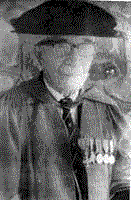 was also the founder and first curator of the Sierra Leone Museum.
was also the founder and first curator of the Sierra Leone Museum.
McCormack Charles Farrell Easmon was born in Accra in the Gold Coast
(Ghana) where his father, a prominent Krio doctor, was working at the time.
He was educated at the CMS Grammar School in Freetown and later at St.
Paul's Preparatory School in London. He attended Epsom College in Surrey
and, after graduating in 1907, was awarded scholarships to study medicine
at the Medical School of St. Mary's Hospital in London. He qualified in
medicine and surgery in 1912, and the following year passed the examination
of the London School of Tropical Medicine.
When Dr. Easmon returned to Sierra Leone in 1913, he was refused a post
in the West African Medical Service because of his colour. There were then
two categories of doctors — Europeans in the "colonial service"
and Africans in the "local service." Dr. Easmon, forced into the separate
and lower category despite his excellent qualifications, became Country
Hospital Native Medical Officer. But he campaigned for years against racial
discrimination in the medical service, earning the antipathy of the British
authorities who called him the "Yellow Peril." During World War I, Dr.
Easmon enlisted in the army and served as a medical officer in the Cameroons.
After the war, he returned to England for further study and, in 1925, was
awarded a medical qualification in obstetrics and gynaecology.
For the next twenty years, M.C.F. Easmon served in a variety of medical
posts in the protectorate, where he acquired a profound interest in the
customs and traditions of the upcountry peoples. He published a series
of scholarly articles on Madam Yoko, various paramount chiefs, the famous
Massaquoi Crown, and Sierra Leone's distinctive country cloth. He also
became an accomplished amateur historian, publishing several well-researched
articles on the early history of the Freetown colony..
Dr. Easmon retired from the medical service in 1945, and had the satisfaction
of seeing the British finally unify the two separate medical services the
following year. But at the age of fifty-five, Dr. Easmon embarked on an
entirely new career. He served part-time on various government boards and
was at one point a director of the Bank of Sierra Leone, but his principal
interest was the preservation of Sierra Leone's historical and cultural
heritage. In 1947, he became the first chairman of the Monuments and Relics
Commission, and presided over the official declaration of twenty national
historic sites. As a member of the Sierra Leone Society, he spearheaded
the founding of the Sierra Leone Museum in 1958 and became its first curator,
working untiringly to acquire worthy exhibits for the museum and to set
up attractive displays. He also worked hard to acquaint the public with
Sierra Leone's history and culture, hosting a popular radio programme called
"Sierra Leone in Retrospect." In 1954, Dr. Easmon was awarded the Order
of the British Empire (O.B.E.).
Dr. M.C.F. Easmon fell ill while on holiday in England in 1969 and never
returned to Sierra Leone. He had won his battle against racial discrimination
in the medical service, but his work to preserve Sierra Leone's historical
and cultural heritage had only just begun. Dr. Easmon was a pioneer in
the field of cultural nationalism. He leaves behind an example well worth
following.
JOHN AKAR
(1927-1975)
AMBASSADOR OF CULTURE AND VERSATILE ENTERTAINER
John Joseph Akar was born in 1927 at Rotifunk, Bumpe Chiefdom in what
is today Moyamba District, where he attended the E.U.B. 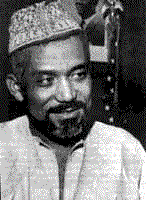 school. Subsequently he went on to the Albert Academy before proceeding
to the United States and Britain to continue his studies. During his sojourn
abroad, he distinguished himself as a good scholar and a versatile communicator
and entertainer. He studied commercial radio and television in America,
Britain, France and the West Indies, and appeared on television and in
films.
school. Subsequently he went on to the Albert Academy before proceeding
to the United States and Britain to continue his studies. During his sojourn
abroad, he distinguished himself as a good scholar and a versatile communicator
and entertainer. He studied commercial radio and television in America,
Britain, France and the West Indies, and appeared on television and in
films.
In 1960, he was appointed the first indigenous Director of Broadcasting,
and during his tenure he brought creative programme leadership to the Sierra
Leone Broadcasting Service. Through him, Sierra Leone broadcasting was
raised to the highest professional standards that became the envy of the
region. His aim was to get the Sierra Leone Broadcasting Service to reflect
more and more the true image of the country, its music, its songs and its
talent. His influence was clearly distinctive in these area —
he was the writer of the music of the Sierra Leone National Anthem.
He founded the National Dance Troupe and used it as a vehicle to encourage
Sierra Leoneans to be proud of their rich cultural heritage. He led the
troupe on many successful performances around the world. After the troupe's
participation in the 1964 New York World's Fair, the following report was
made: "This talented folk dance troupe imposed a vivid image of Sierra
Leone on the minds of thousands of Americans when it took the New York
World's Fair by storm in 1964." In fact, it was voted the best dance ensemble
at the fair, and was presented with a gold plaque. In 1965, the troupe
performed at the Commonwealth Arts Festival in London, where it had a great
success. The following year, the troupe performed at the Festival of Negro
Arts in Dakar, after which they did a four month tour of Western Europe.
The pioneering role played by John Akar awakened cultural consciousness
among rural as well as urban populations, and firmly established Sierra
Leone's place on the world cultural map. The immense potentialities of
our indigenous cultures to rouse the people to action, cement national
unity, and to open out to the wonderful realities of our times lay dormant,
and if there is one things that John Akar achieved for his countrymen,
it was to instill in them a sense of pride, a love for country and an awareness
of their rich cultural heritage.
EBENEZER CALENDAR
(1912-1985)
POPULAR CULTURAL MUSICIAN
Ebenezer Calendar was a cultural musician, historian and social commentator
who used his popular maringa music to entertain and 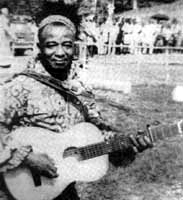 educate his fellow countrymen.
educate his fellow countrymen.
He was born in Freetown on November 19, 1912 of a Jamaican father and
a Sierra Leonean mother. Calendar had an interrupted primary school career,
attending Bishop Edwin Tabernacle and U..B.C. primary schools. According
to some sources, this was the result of the hard times which the family
experienced after the death of Calendar's father. Calendar left school
at the age of fifteen because his mother could not afford to pay his way
through secondary school. Other sources, however, suggest that Calendar
dropped out of school of his own free will, influenced largely by his young
friends. He joined the Public Works Department (P.W.D.) in 1927 as an apprentice
carpenter. By 1930, he had become a qualified carpenter, and he was employed
by Pa Alimamy Boungie, an undertaker at Kissy Street. Pa Boungie's undertaker
shop used to conduct wake-keeping ceremonies for bereaved families. Thus
Calendar would learn coffin-making during the day, and at night he would
be among the men Pa Boungie would send to sing at wake-keeping ceremonies.
About this time, Calendar and two of his friends formed a small musical
group. They practiced on open grounds, and on-lookers would sometimes give
them money. Later, they began getting invitations to perform at weddings,
parties and other festive occasions. All this was just part-time, reserved
for evenings, as Calendar continued working for Pa Boungie. Before finally
embarking on a full-time musical career, Calendar worked for some time
with the Sierra Leone Railway, opened and ran an undertaker shop, and then
was employed as cabinet-maker for the United African Company Limited (U.A.C.).
A versatile musician, Calendar learnt to play several different musical
instruments, including the mandolin, the cornet, rhythm guitar and the
trumpet. Calendar's group in the 1940s and 1950s relied upon a combination
of locally-produced instruments like the bata (hand drum) and the triangle,
and Western instruments like the guitar and the tambourine to produce his
distinctive maringa rhythm. In 1951, he was commissioned by DECCA Recording
Company to record a song commemorating the launching of the newly-introduced
double-decker buses. The tune was an instant success, and Calendar established
his reputation as a popular songwriter/musician celebrating contemporary
events of the period. From this point of view, he can be looked upon as
a social historian, commenting on contemporary happenings.
Calendar's early songs formed part of the dance music of the fifties
and sixties, and most of his compatriots will remember the swinging
rhythm of the hit song "Fire, Fire." As he grew older, his music became
more philosophical, and he began to consider himself more as a teacher
with the responsibility of imparting the lessons he gained from life to
a younger generation. Wrapped in delightful music, Calendar preached the
morality of a Krio-Christian society, with the rhythm making it easy for
the people to identify with him and the values he advocated.
Ebenezer Calendar also helped popularise the radio when he joined the
Sierra Leone Broadcasting Service in 1952 as a programme officer. He performed
with the Sierra Leone National Dance Troup at the Commonwealth Arts Festival
in 1965 and 1966. On April 19, 1983 he was awarded the Certificate of Honour
by the President of Sierra Leone for his meritorious service in the field
of indigenous music. When he died in 1985, music groups from all over Freetown
converged on his home at the foot of Mt. Aureol and played his songs continuously
for twenty-four hours. Thousands gathered to remember the man they
all loved and admired.
Ebenezer Calendar's place in Sierra Leone's history is assured because
of his significant contribution to the development of a distinctively Sierra
Leonean musical tradition.
SALIA KOROMA
(1903-)
MINSTREL POET
Salia Koroma was born in Segbwema although his parents had come from
Kpa-Mende country. As a young man, Salia's father left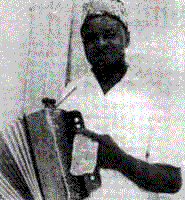 him in the care of his mother while he went to seek his fortune elsewhere.
Salia was anxious to go to school but his uncles, who were responsible
for him in the absence of his father, did not feel disposed to send him
to school. Rather, they sent their own children. The young Salia therefore
went in search of his father whom he finally found at Boajibu in the Sembaru
Chiefdom. He expressed his desire for education and his father promised
that he would indeed "send him to school." He then proceeded to give young
Salia an accordion and said, "This is your school."
him in the care of his mother while he went to seek his fortune elsewhere.
Salia was anxious to go to school but his uncles, who were responsible
for him in the absence of his father, did not feel disposed to send him
to school. Rather, they sent their own children. The young Salia therefore
went in search of his father whom he finally found at Boajibu in the Sembaru
Chiefdom. He expressed his desire for education and his father promised
that he would indeed "send him to school." He then proceeded to give young
Salia an accordion and said, "This is your school."
Salia was bitterly disappointed at first, but on the insistence of his
father he settled down to playing the accordion "to the warriors and not
for Europeans." From then on, Salia took his "education" seriously. Through
hard work, determination and an innate poetic talent, he taught himself
to play the accordion. Although his father was a renowned accordionist
himself, Salia learnt by his own experience. He spoilt many accordions
in the process but his father always bought him a new one.
Gradually, Salia's reputation began to spread, first in Mendeland and
later all over Sierra Leone. He travelled from place to place entertaining
chiefs and people with his stories and songs. After serving several chiefs,
he moved to Rotifunk where he was court entertainer to Chief Albert Caulker
for some time. After his stay in Rotifunk, he moved to Moyamba to work
for the famous Chief Julius Gulama.
Always searching for knowledge and true to the spirit of minstrels,
Salia was constantly on the move. He eventually ended up in Freetown where
he joined the Sierra Leone Police Force until the outbreak of the Second
World War. Up to this day, Salia remembers distinctly that his number in
the police force was 377. His police duties did not stop him from playing
the accordion.
Salia has composed hundreds of songs and entertained people in all walks
of life all over the country. He has been a symbol of the artist in our
traditional society, and he has spent all his life trying to establish
the fact that there is dignity in art — especially indigenous
art. He is disappointed that Sierra Leone does not give enough appreciation
to the efforts of indigenous artists. But he remains optimistic, and believes
that even in his old age, he can still contribute to his art and to the
nation's cultural development.
NEMGBANA
(ca.. 1710-1793)
LAST TEMNE RULER OF THE SIERRA LEONE PENINSULA
Nembgana, often written Naimbana, was regent of the Koya Kingdom from
1775 to 1793. It was Nemgbana who signed the treaty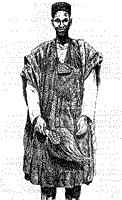 making way for the establishment of the British colony on the Sierra Leone
peninsula. He was a progressive ruler who was opposed to the slave trade,
though he could do little to fight it under the circumstances. He joined
the advance of Western influence by sending two of his sons to Europe to
be educated.
making way for the establishment of the British colony on the Sierra Leone
peninsula. He was a progressive ruler who was opposed to the slave trade,
though he could do little to fight it under the circumstances. He joined
the advance of Western influence by sending two of his sons to Europe to
be educated.
Nemgbana became regent of Koya at the death of the Koya king in 1775.
By Koya custom, when the Obai (king) died, the leading sub-rulers
became rulers as regent in turn until the last of them died, when a new
Obai
was crowned. Nemgbana was sub-ruler of Rogbana up the Sierra Leone
estuary. He was described in one account by the name of Panabouro, but
all other accounts call him Nemgbana. It seems clear that "Gbana" was his
title as sub-ruler of Rogbana, "ro" being a Temne prefix meaning "to" or
"at". One account indicates that when Europeans first wanted to record
his name and asked for this in English, he replied "name Gbana ("my name
is Gbana"), and this was recorded as Nemgbana.
Nemgbana was a ruler ahead of his time. Against the increasing suspicion
of his elders, he continued to allow the British to stay in the peninsula
which had been unwittingly ceded to them by his sub-chief, Tom. Nemgbana
later signed the treaty in 1788 giving this land to the colony. He, himself,
may have done so unwittingly, as he could not read or write, and may not
have realised that the British meant to take permanent possession. In any
case, his other actions showed that he was not totally opposed to the presence
of the colony in his territory. In fact, in 1785, before the colony was
founded, he had granted a French officer land on Gambia Island, close to
what is now Hastings, though the French had abandoned the island soon after.
Nemgbana was, however, opposed to the slave trade, and expressed his resentment
on a few occasions to colony officials. Many of his subjects and the European
traders on the coast did, however, depend on it, and he wisely realised
that there was nothing he could do at the time to halt it.
Nemgbana did not stop at verbal protestations of interest in contact
with Europeans. While negotiating with the French, he sent one of his sons
to be educated in France. He also later sent another son, John Frederick
Nemgbana, under the care of the directors of the Sierra Leone Company,
to be educated in England. A third son was sent northwards to acquire an
Islamic education. Nemgbana must, thus, have had foresight as to the usefulness
the education his sons acquired would have in dealings with his neighbours,
both the Europeans at the colony and his Islamic neighbours further north.
In fact, he employed one of the settlers from the colony, one Abram Elliot
Griffith, as his clerk and later, chief adviser. Griffith was given one
of his daughters, later named Clara, in marriage.
Nemgbana has become something of a folk legend over the years, and his
name is recognised by many who do not know exactly who he was or what he
did. Nemgbana was, in fact, the last traditional Temne ruler in the area
that ultimately became the city of Freetown.
THOMAS PETERS
(ca. 1738-1792)
TRUE FOUNDER OF FREETOWN
Thomas Peters was a courageous Afro-American whose efforts made possible
the founding of Freetown.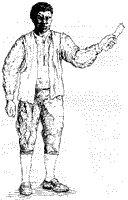
He was born a slave in the North American colonies and worked in his
master's flour mill in North Carolina. During the American Revolution,
Peters ran away and joined the British Army, becoming a sergeant in the
Black Pioneers. When the British lost the war, they evacuated Peters
and hundreds of other Black Loyalists to Nova Scotia — but
after seven years in Canada, the former slaves had still received no land
and were living only on a meagre government ration and suffering from the
cold.
Peters, though poor and uneducated, found the courage to travel to England
in search of help for his people. He was in grave danger from the moment
he left Canada, as he was still legally a slave in the newly-independent
United States, and could have been taken there and sold back into slavery
by an unscrupulous sea captain. But Thomas Peters managed to reach London,
and he convinced the Sierra Leone Company to send ships to help his people
establish a colony in Africa.
He then returned to Nova Scotia and, by sheer force of personality,
persuaded over eleven hundred former slaves to join him in the voyage to
Sierra Leone. Thomas Peters and his "Nova Scotians" founded Freetown in
1792 near the site of the Province of Freedom, which had been destroyed
several years earlier.
But problems soon developed when the white men of the Sierra Leone Company
insisted on running the colony as they saw fit. Thomas Peters confronted
the English commander, demanding that his people run their own affairs
through an elected committee, but he was unsuccessful in his attempt to
establish self-rule. He died shortly afterwards, a victim of malaria in
the colony's first rainy season.
Thomas Peters was totally committed to freedom, and fought for it until
the very last day of his life. More than anyone else, he exemplifies the
spirit of hope and determination that gave birth to the city of Freetown.
PA DEMBA
(1794)
A MAN OF COMPASSION
Pa Demba was a simple village headman whose generous offer of help may
have saved the 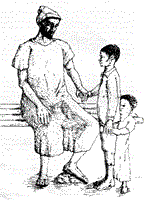 Freetown colony.
Freetown colony.
When Freetown was founded, Pa Demba ruled a small village near the junction
of modern Campbell Street and Pademba Road; and his little town was probably
the closest Temne village to the Freetown settlement. In September,
1794, five French warships sailed into the harbour and attacked the tiny
colony. The French fired their great cannons time and again at the fragile
houses, driving the British officers and Nova Scotian settlers into the
surrounding countryside. Then they landed and looted the houses and storerooms
and set fire to every building, including the church, governor's house,
and apothecary shop.
The Nova Scotian settlers were in a desperate situation. The rainy season
had not yet ended, and they had no shelter and no food to last them until
the harvest. Worse still, they were in constant danger of attack by the
Koya Temne, who felt the British had cheated them to obtain land for the
new colony. The settlers were helpless and surrounded by enemies, and in
this volatile situation, Pa Demba stepped forward. He offered his little
village as a refuge for the Nova Scotian school mistress and all the children
of the colony, and agreed to take in as many of the other homeless as he
possibly could. He made this compassionate gesture despite the fact that
it was the hungry season for his own people and despite the bitter feelings
of the other Temne chiefs who would have liked to see the Freetown colony
destroyed. Pa Demba set aside political differences and did what was humanly
right. He is a powerful symbol of reconciliation among the ethnic
groups, and his example shows that when times are difficult, Sierra Leoneans
come together as one people, and one nation.
GUMBU SMART
(ca. 1750-1820)
LOKO RULER AND ENTREPRENEUR
Gumbu Smart was ruler of Rokon in Masimera Country by the end of the
18th century. By dint of hard work and enterprise, he 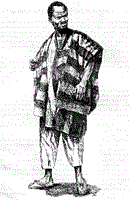 built up a large and thriving centre at Rokon. Though Loko, he did not
hesitate to join the Wunde, a Kpaa Mende secret society, or to settle
in the heart of Masimera Temne country.
built up a large and thriving centre at Rokon. Though Loko, he did not
hesitate to join the Wunde, a Kpaa Mende secret society, or to settle
in the heart of Masimera Temne country.
Smart's real name was Koko and he hailed from Kalangba in what is now
the Gbendembu - Gowahun Chiefdom in Bombali District. He had accidentally
killed his brother as a boy and had fled from home. Captured and sold as
a slave to British slave traders on Bunce Island, he displayed so much
industry there that his new masters gave him the name of 'Smart' and kept
him as an employee, rather than selling him off like the other slaves.
The British traders regularly advanced goods to Smart to go inland as
a slave-buying agent, after they had built up a lot of confidence in him.
Instead of always buying slaves for his British owners, he sometimes bought
his own Loko people, not to be sold as slaves, but to become his own followers.
By this process, he built up a powerful force around the middle Rokel
River, and ultimately severed connection with his former British masters
at Bunce Island. He had become too powerful for them even to ask him for
a refund of the goods they had advanced him.. In fact, in 1806, one of
the British employees of Bunce Island visited Gumbu Smart at Rokon and
then wrote about him admiringly in a book he published the following year.
To enhance his military skills and build up alliances, Smart joined
the Wunde society, which specialises in military training. He then took
the name of "Gumbu" meaning "fire" in Mende. When war erupted between the
Temne of Masimera and Marampa, Gumbu Smart was called to help Masimera
and, as a reward, was given control of the Town of Rokon, where he settled
with his followers. Rokon under Gumbu Smart became a large, well-laid-out
town with wide streets and well-built houses. It became the most powerful
settlement in the area and a major commercial centre. Gumbu Smart played
an important role in regulating the commerce passing down the Rokel River
on the way to the Atlantic coast. After the founding of the Freetown colony,
he was also engaged in active trading with the new settlement.. Gumbu Smart,
an accomplished diplomat, was careful to maintain alliances. In the 1790s,
he made friends with the officials of the Sierra Leone Company which ruled
the Freetown settlement. European missionaries of the London Missionary
Society were sent to Rokon, and Gumbu Smart received them warmly. Though
the missionaries did no conversion, one of them, Henderson wanted to marry
Gumbu Smart's young daughter. Smart even helped the Sierra Leone Company
in its wars against the Koya Temne, led by King Tom in 1801.
Gumbu Smart died about the 1820s and he left behind a rich legacy of
dynamism and enterprise. Indeed, it is not surprising that the Smart family,
descended from Gumbu, has given Sierra Leone so many outstanding leaders
down through the years.
DALA MODU DUMBUYA
(ca. 1770-1842)
SOSO RULER, BUSINESSMAN, AND DIPLOMAT
Dala Modu should be remembers as the single most important liaison between
the British Colonial Government and the local 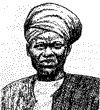 rulers in the interior in the early decades of the British Colony at Sierra
Leone. His efforts helped in solving many a conflict between the
Colony and interior rulers. His reputation as a major commercial force
was enhanced in the process, and he built up the prominent Soso community
around Lungi in the Kafu Bullom country.
rulers in the interior in the early decades of the British Colony at Sierra
Leone. His efforts helped in solving many a conflict between the
Colony and interior rulers. His reputation as a major commercial force
was enhanced in the process, and he built up the prominent Soso community
around Lungi in the Kafu Bullom country.
Dala Modu was born into a family of traders at Wonkafong in Sumbuya
near Conakry, where his father, Fenda Modu, had been advisor to the King
of Sumbuya and Headman of Wonkafong. Dala Modu first came to Freetown with
his father in 1794. Desirous of fostering his commercial contacts with
the new colony, Fenda Modu sent his son Dala Modu with fifty followers
in 1795 to settle on the outskirts of Freetown. The town Dala Modu built
up there, named Dalamodiya after him, quickly became a commercial centre,
and he became landlord for many traders from the interior, mostly from
his own Soso ethnic group. Dala Modu was welcomed by the governor, who
was also keen on developing the trade with the interior on which the colony's
survival depended. In Freetown Dala Modu learnt English and studied the
colony's monetary system and weights and measures.
Dala Modu's business activities became very extensive, involving colony
officials, both European and African, and the local traders, for whom he
acted as agent. He became the primary landlord to visiting traders from
the distant interior, giving them advice and assistance on how to get the
best out of their trade goods in the colony. In this process, he developed
close contacts with the Freetown merchants to whom he directed the interior
traders.
Dala Modu became the local agent to the European firm of Macauley and
Babington in 1826. The European agent of that Company, Kenneth Macauley,
was a close associate of Dala Modu when he acted as governor in that year.
Modu organised the felling and processing of timber for the company from
his base at Madina on the Bullom Shore, where he had lived since 1806.
This was done with a large band of servile labour he retained there. For
the 1826 season alone, he received £1,000 as partial payment.
In 1834, many gold traders from the interior came to the colony through
him, bringing him much wealth in broker's fees.
Dala Modu used his wealth and business contacts to build for himself
a prominent position in the relations between the colony officials and
the local rulers in the interior. He was helped in this by his powerful
family connections in the Northern River areas (north of the Scarcies),
where his family owned parts of the major trading islands. These came in
handy in treaties of cession he negotiated in 1818 and 1825 with the colonial
government, which was eager to use these islands, like Matacong and the
Isles de Los, as customs posts.
But Dala Modu's personal qualities of diplomacy undoubtedly played a
major role in winning the favoured position he came to enjoy. As early
as 1802, soon after the rebellion of the Nova Scotian settlers in the colony,
Dala Modu was instrumental in convincing the Mandinka chiefs to withdraw
their support for the rebels and to hand over the leaders of the uprising
to the British. But, in 1806, he was accused of slave trading and other
charges. When called to answer these charges, he appeared in Muslim robes
rather than the European dress he was used to wearing in Freetown. This
angered the British authorities, who proceeded to expel him from the colony.
Dala Modu then moved to Madina on the Bullom Shore from where he continued
his business activities. It was there that he built up the Soso community
with migrants coming from the interior. Dala Modu thus because effectively
the King of Kafu Bullom and Loko Masama, but his influence extended as
far as the Port Loko areas. In fact, he became ruler of Rokon on the Rokel
in 1837.
The colonial government in Freetown soon realised that it needed Dala
Modu's services in settling disputes in the interior. From 1818, when he
arranged the cession of the Isles de Los to the British, he started receiving
an annual payment from them. Between 1820 and 1841, Dala Modu arranged
peace talks on a number of occasions to settle local disputes the Colony
Government felt were inhibiting trade. These included the rebellion on
the north Rokel in 1835, and the Temne/Loko war in 1836. Though he did
not get along well with some of the governors, succeeding ones were quick
to realise his worth and do business with him. Governor Henry Dundas Campbell
visited him in 1835 and was struck by his intelligence and affluent style
of living.
When Dala Modu died, over eighty cows were slaughtered during his funeral
ceremonies, attended by British and African officials from the colony and
by many local rulers from the interior. Dala Modu was among the first indigenous
entrepreneurs to take advantage of the new business opportunities
arising after the abolition of the slave trade. His dynamism, commercial
acumen, and sound political judgment remain as examples for us today.
JOHN EZZIDIO
(ca. 1810-1872)
FROM RECAPTIVE SLAVE TO MAYOR
John Ezzidio was a recaptive slave from Nupe, in Nigeria, who rose to
become a wealthy merchant, the Mayor of Freetown, 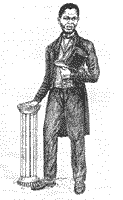 and the first African elected to Sierra Leone's Legislative Council.
and the first African elected to Sierra Leone's Legislative Council.
Ezzidio was kidnapped as a small child and taken south to the Yoruba
country. In 1827, while in his teens, he was sold to white slave traders
who put him on a ship bound for Brazil. But the British navy's Africa squadron
captured the ship and released the "recaptives", including young Ezzidio,
at the city of Freetown. The young man now began a new life as the apprentice
to Jean Billaud, a French shopkeeper. Billaud called the former slave "Isadore",
which gradually became pronounced as "Ezzidio".
John Ezzidio, bright, resourceful, and ambitious, took easily to the
world of commerce. He worked for Billaud for several years and, after the
Frenchman died, found employment with other local merchants. Within ten
years, Ezzidio had saved enough money to begin his own business. By 1841,
he had purchased land and built a house. In 1844, he became an alderman
on the city council; and in 1845, the mayor of Freetown.
Ezzidio was active in the Wesleyan Mission as a class leader and local
preacher. In the 1850s, Rev. Thomas Dove, the mission superintendent, took
Ezzidio to England where he made contacts with large wholesale firms from
which he began to import goods directly, without going through middlemen.
By the 1850s, Ezzidio had built up one of the largest and most prosperous
businesses in the colony. In 1863, after a constitutional change established
the Legislative Council, Ezzidio was elected an unofficial member of the
colony's mercantile community, defeating a European candidate. He was the
first African to serve on the council and, because the British soon abolished
the elective principle, he was the only African to be elected until
that principle was reintroduced in 1924. Ezzidio served on the council
from 1863 until the eve of his death in 1872, holding the title of "Honourable".
The last years of Ezzidio's life were marked by a bitter feud with Rev.
Benjamin Tregaskis, the new superintendent of the Wesleyan mission. Tregaskis,
a man of dictatorial personality, opposed Ezzidio's influence in the mission
and his approach to church policy.. The feud seems to have damaged both
Ezzidio's health and his financial position. But John Ezzidio remains one
of the outstanding success stories of early Freetown. He arrived on a slave
ship — naked, penniless, and friendless — but
rose ultimately to the heights of Sierra Leone society. His success came
through faith, intelligence, determination and hard work.
EDWARD WILMOT BLYDEN
(1832-1912)
THE FATHER OF PAN-AFRICANISM
Edward Wilmot Blyden was the foremost African intellectual of the 19th
century. His brilliant career, in both Liberia and Sierra 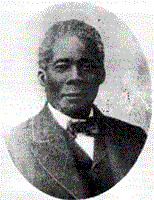 Leone, spanned the fields of religion, education, journalism, politics,
and philosophy. He is best remembered as an African patriot whose writings
contributed significantly to the rise of Pan-Africanism.
Leone, spanned the fields of religion, education, journalism, politics,
and philosophy. He is best remembered as an African patriot whose writings
contributed significantly to the rise of Pan-Africanism.
Edward Blyden was born in the Virgin Islands in the West Indies, a descendant
of Ibo slaves from Nigeria. He was a gifted student, and at the age of
eighteen, attempted to enroll at a theological college in the United States.
But the college would not accept him because he was black, and he experienced
many frightful scenes in the U.S. at a time when slavery was still lawful.
In 1851, young Blyden emigrated to Liberia with the intention of building
a new life in Africa. He would remain there for more than thirty years,
rising gradually to the highest levels of Liberian society. During his
Liberian career, Blyden was a Presbyterian minister, a newspaper editor,
a professor of classics, President of Liberia College, Ambassador to Great
Britain, Minister of the Interior, and Secretary of State. In 1885, he
was an unsuccessful candidate for the Presidency.
But Edward Blyden was also well known in Sierra Leone, where had spent
two years (1871-73) as Government Agent to the Interior, leading two official
expeditions — one to Falaba and other other to Futa Jallon.
In 1885, after his unsuccessful bid for the presidency of Liberia, Blyden
based permanently in Freetown. In fact, Blyden was in many ways a greater
intellectual force in Sierra Leone than in Liberia. He stirred controversy
and lively debate in the Krio community by opposing the indiscriminate
emulation of European culture.. He told the Krios that they were "de-Africanised,"
scolded them for holding themselves aloof from the upcountry peoples, and
advised them to remember always that "you are Africans." After the 1887
publication of his masterpiece, Christianity, Islam, and the Negro Race,
some Krios under Blyden's influence began to adopt African names
and even to emulate traditional African dress.
Edward Blyden was one of the most original thinkers of his time, and
although some of his ideas seem archaic today, he was a major force for
the defence of Africans and of black civilisation. Blyden looked forward
to the rise of an independent West African nation, and he encouraged British
colonial efforts as a means of uniting this vast area. At the same time,
Blyden regarded Africans as having a unique "personality" and a distinctive
culture equal to, but different from, that of Europeans. He urged the British
to allow Africans more autonomy in political and church matters, and argued
against the imposition of European culture. As early as 1872, Blyden called
for an independent West African University to be run solely by Africans,
teaching African languages, cultures, and values. Blyden, though a Christian
himself, viewed Muslims as more authentically African, and he repeatedly
urged the British authorities to involve Muslim Africans in various ways
in their colonial enterprise. Blyden taught himself to speak Arabic, and
maintained close relations for many years with the Muslim community in
Freetown. In his later years,, he was Director of Mohammedan Education
in Sierra Leone.
When Edward Wilmot Blyden died in 1912, his funeral was attended by
many hundreds of people from throughout the Freetown community, including
both Muslims, who bore the coffin, and his fellow Christians. Later generations
of black intellectuals, in both Africa and America, have looked to Edward
Blyden for inspiration in the areas of Pan-Africanism and cultural nationalism.
AFRICANUS HORTON
(1835-1883)
SCIENTIST AND AFRICAN PATRIOT
Africanus Horton was a surgeon, scientist, soldier, and a political
thinker who worked toward African independence a century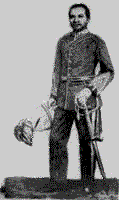 before it occurred.
before it occurred.
Born James Beale Horton, he grew up on Gloucester Village, the son of
an Ibo recaptive who worked as a carpenter. Horton was educated at the
CMS Grammar School and at the Fourah Bay Institution (later Fourah Bay
College), and in 1853 received a War Office scholarship to study medicine
in Great Britain. He studied at King's College, London and Edinburgh University,
qualifying as a medical doctor in 1859. While a student, he took the name
"Africanus" as an emblem of pride in his African homeland.
Africanus Horton joined the British Army Medical Service the year he
completed his medical studies, and was appointed assistant staff surgeon.
He was one of the first Africans to qualify as a medical doctor, and one
of the first to serve as an officer in the British Army. He continued in
the army for the next twenty-one years, attaining the rank of lieutenant-colonel.
He spent most of that time in the Gold Coast (Ghana), where he took an
active interest in scientific research. He published several studies involving
tropical diseases, climate and meteorology, and geology. But despite his
dedicated and professionally competent service, the British authorities
were not anxious to see an African advance too far. They shifted Horton
constantly from one post to another, and rejected his application in 1872
for the position of governor of the Gold Coast.
But, despite his disappointments, Horton continued to believe that Africans
could advance under the banner of British colonialism. In 1865 a Select
Committee of the British House of Commons had suggested that Africans be
given increasing responsibility for administering their own affairs. The
same year, Horton published Political Economy of British Western Africa,
a book calling for the establishment of a West African University along
British lines. Three years later, he published his popular West African
Countries and Peoples, calling for nothing less than the establishing
of independent West African nations in the Gambia, Sierra Leone, etc. He
argued for British assistance in moving these African countries toward
self-rule, and presented plans for education, economic development, and
medical improvements. But the Select Committee's recommendations were not
popular with British authorities, who looked toward increasing their
control, not decreasing it — and Horton began to be seen as
an enemy of British policy.
Africanus Horton retired from the Army in 1880, and returned to Freetown.
Ever the optimist and believer in progress, he set up a commercial bank
to assist struggling African entrepreneurs. But only three years later,
at the age of forty-eight, he died suddenly of blood poisoning. Horton
had left funds for the setting up of a secondary school of high standard,
but his endowment proved insufficient. Much of his estate went for the
funding of scientific education at the Sierra Leone Training School. Africanus
Horton's countrymen would have to wait for almost a century before his
dreams of political independence would be realised.
SIR SAMUEL LEWIS
(1843-1903)
LEGAL LUMINARY AND MAYOR OF FREETOWN
Sir Samuel Lewis, the third Sierra Leonean to qualify as a barrister,
was the most famous of the early Krio lawyers.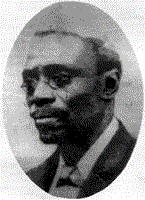
To many young men of the day, it became obvious that a sound education
and training in one of the respected professions — law, medicine
and the clergy — was indispensable for leadership positions
among their people, or for a career in the Colonial Government.
On the completion of his education however, Lewis, a man of firm conviction
and one who valued his independence, declined to serve in government office
so his hands would not be tied. He worked incessantly for his clients and
devoted most of his energies to their defence. He was a very successful
lawyer, winning most of his cases, but he still found time to criticise
the Colonial Government over policies with which he disagreed. One such
disagreement erupted into a violent dispute with Governor Cardew soon after
the latter became Governor.
In spite of his reluctance to serve in the Colonial Government, the
yearning to serve his people led him to accept membership in the Legislative
Council in 1882. Sir Samuel Lewis served his people well and honourably,
and when Freetown because a municipality in 1865, he was the obvious choice
for Mayor. In 1896, he was made a knight, the first West African to achieve
such an honour.
Like most pioneers, Sir Samuel's ideas were far in advance of his times.
At a time when most settlers saw people of the hinterland as heathen strangers,
he called for the annexation of the interior so that peace could be maintained
in those areas, and the Krio of the Colony could benefit through commerce
and the development of the natural resources of the interior. He blamed
much of the misunderstanding between the people of the Colony and those
of the then interior on the lack of communication and contact between the
two. He therefore advocated for improved communications between the Colony
and the hinterland so that there could be better understanding of the interior
and greater opportunity to explore the many possibilities it offered.
In perceiving the possibility of harmonious, purposeful and beneficial
relations between people of different cultures and regions, Sir Samuel
Lewis left his mark as one of the first men to envision a united Sierra
Leone.
JOHN HENRY MALAMAH THOMAS
(1844-1922)
OUTSTANDING ENTREPRENEUR AND MAYOR
John Henry Malamah Thomas is an outstanding example of a self-made magnate.
He promoted trade between Colony and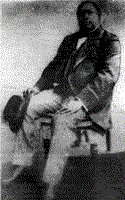 "up-country", served as Mayor of Freetown eight times, and became an unofficial
member of the Legislative Council in 1907.
"up-country", served as Mayor of Freetown eight times, and became an unofficial
member of the Legislative Council in 1907.
Born at Hastings of Aku recaptive parents, his father died when he was
three years old. Malamah Thomas started school in 1845, but the family's
straitened circumstances made it necessary for him to spend the better
part of his time helping his mother in her bid to make ends meet. At the
age of fourteen, John left school and entered upon a business career. Starting
as a clerk/trainee with a number of business concerns, he later set out
on his own.
He started his business with a loan of £100 secured from
a friend, Dr. Robert Smith. He built a factory on the Rokel River at a
place called Malamah — that was how he came by the nickname
"Malamah". Some years later, he closed his business on the Rokel and moved
to the Scarcies where he worked as an agent of the Compagnie du Senegal
(later Compagnie Francaise de L'Afrique Occidental, popularly known as
CFAO). But before taking up his post on the Scarcies in 1882 he opened
a small shop in Freetown under the management of his wife.
Six years later, Malamah Thomas resigned the CFAO agency and returned
to Freetown to operate his business. Bringing his twenty-three years of
commercial experience to bear upon the running of the business, it quickly
expanded and prospered, and Thomas became one of the leading merchants
in the city. He traded chiefly in cloth fabrics, and patented in England
his own brand of cotton known as "Malamah baft". The beautiful "Malamah
House" he built at East Street stands today as an eloquent monument of
his commercial prowess and success.
Thomas also served both church and state. He was for thirteen years
warden of Holy Trinity Church of which he later became Treasurer. In 1891,
he was appointed Charity Commissioner, and became Commissioner of the Peace
in 1894. In the Freetown municipal elections of 1903, he entered the City
Council for the East Ward. In 1904, he was elected Mayor of Freetown, and
held that position eight years.
When in 1907, he was appointed an unofficial member of the Legislative
Council, members of the Hastings Re-Union Committee presented him with
a Silver Cup in recognition of his "present position as a native merchant
of sterling repute, a Justice of the Peace, thrice a City Magistrate, and
now a member of the Legislative Council".
His political activities went beyond Sierra Leone. He became President
of the local branch of the National Congress of British West Africa, a
body formed in 1920, advocating united political agitation for self-government
among the African peoples of British West Africa. He supported the Congress
with both his money and time.
John Henry Malamah Thomas died in Freetown on January 18, 1922. He was
deeply mourned, and the glowing tribute in the local "Sierra Leone Weekly
News" was testimony to the contribution he made to the development of Sierra
Leone.
JOHN AUGUSTUS ABAYOMI-COLE
(1848-1943)
DISTINGUISHED MEDICAL DOCTOR AND HERBALIST
John Augustus Abayomi-Cole was a man of many skills. He was an eminent
medical doctor and herbalist, a teacher, a preacher, 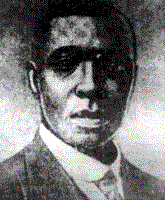 a farmer, a manufacturer, and a politician.
a farmer, a manufacturer, and a politician.
Dr. Abayomi-Cole was born in 1848 of Sierra Leonean parents in Abeokuta,
Nigeria. At an early age, he lived with his uncle, Archdeacon Robbin, who
was a Sierra Leonean missionary in Nigeria. When Archdeacon Robbin returned
to Freetown, he brought young Abayomi-Cole with him. In Freetown he was
put under the tutelage of the great A.B.C. Sibthorpe at Hastings, and was
later sent to the C.M.S. Grammar School where he completed his secondary
education.
On leaving school, he taught at the Evangelical United Brethren Church
School at Shenge in Sherbro country, and in his mid-twenties he left for
the United States of America where he was ordained a Minister in the American
Wesleyan Methodist church. He later qualified as a medical doctor and became
a Fellow of the Society of Apothecaries (F.S.A.) of the United States.
Shortly thereafter, he became an affiliate of the National Association
of Medical Herbalists in Great Britain.
Combining his scientific training with a wealth of knowledge on the
healing properties of traditional herbs, roots and leaves, Dr. Abayomi-Cole's
fame soon spread to all parts of Sierra Leone, and even to neighbouring
Liberia. His cures were a mixture of the orthodox and the traditional.
He cured rheumatic pains, skin diseases such as "alay", nervous and eye
diseases, etc. During the 1918 Spanish influenza epidemic, he invented
a preparation of "tea-bush", "camphor", lime and spirit which saved many
lives at a time when the influenza death toll was so high that people were
buried in trenches in Freetown and other world capitals. One of his well-known
preparations as an antidote for poison, "ekpa", is still used in
Krio villages homes in the Western Area. It is also used as a remedy for
various stomach disorders.
Dr. Abayomi-Cole's herbal practice became more popular and lucrative
than those of medical practitioners who had studied orthodox medicine in
Britain, and he became a scientific and medical adviser to Governor Sir
Leslie Probyn.
At the turn of the century, malaria was the greatest scourge of West
Africa, and was taking a deadly toll particularly of Europeans. Dr. Abayomi-Cole
was called upon by the Colonial Government to help combat the disease.
He made an effective preparation of herbs, containing as its main ingredients
"broomstone" leaves and "agiri". But he found that his cured patients
returned within a few weeks with the same symptoms. Through intensive medical
research, he was able to establish that poor environmental sanitation was
the root cause of the relapse — mosquitoes were breeding in
stagnant pools of water around houses. He organised groups of voluntary
workers known as "mosquito missionaries" who went from compound to compound
advising people on the necessity of keeping their living areas clean. The
scheme worked so well that the Colonial Government later paid the volunteers
monthly.
Although he is known mainly as a medical doctor and herbalist, Dr. Abayomi-Cole
also turned his attention to other pursuits. He was engaged in agriculture
and, among other things, he produced and cured tobacco. He also produced
brandy, sugar and soap, all of very high quality. In politics, he joined,
formed or inspired the formation of pressure groups with the aim of defending
and upholding the rights, dignity, and respect of his black brothers and
sisters in the face of the racial arrogance and authoritarian tendencies
of colonial officials.
Dr. Abayomi-Cole lived to the great age of ninety-two years, and his
active and productive life in so many fields of endeavour stands as a glowing
example of enterprise, imagination and versatility worthy of recognition
and emulation.
ADELAIDE CASELY HAYFORD
(1868-1960)
CULTURAL NATIONALIST AND EDUCATIONIST
Adelaide Casely Hayford, a strong advocate of cultural nationalism,
was an educationist, short story writer and ardent feminist. Her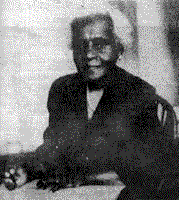 determination to ensure that Sierra Leoneans preserve their national identity
and cultural heritage caused her in 1925 to attend a reception in honour
of the Prince of Wales in traditional African costume, causing a sensation.
determination to ensure that Sierra Leoneans preserve their national identity
and cultural heritage caused her in 1925 to attend a reception in honour
of the Prince of Wales in traditional African costume, causing a sensation.
Adelaide Casely Hayford, née Smith, was born in Freetown
on June 27, 1868. The young Adelaide spent most of her childhood and adolescence
in England where her father had retired in 1872. In England, she attended
the Jersey Ladies College, and at the age of seventeen proceeded to Germany
to study music at the Stuttgart Conservatory.. Adelaide and her sisters
returned to Sierra Leone after twenty-five years abroad.
After spending a few years in Freetown, she returned to England where,
together with her sister, she opened a boarding home for African bachelors.
It was during this period that she married J. E. Casely Hayford, a lawyer,
who was an active advocate of Pan-Africanism and cultural nationalism.
It is probable that her marriage to J. E. Casely Hayford gave her a deeper
insight into African culture and may have influenced her transformation
into a cultural nationalist. Inspired by the ideas of racial pride and
co-operation advanced by Marcus Garvey's Universal Negro Improvement Association
(UNIA), she joined the Ladies Division of the Freetown Branch on her return
and became its President. She resigned from the Association however, in
June, 1920 because of a conflict of interest between the UNIA and the proposed
Girls' Vocational School she intended to establish.. The same year, she
travelled to the United States to study Afro-American educational programmes
for industrial education and to raise funds for the proposed Girls' Vocational
School. In the United States, proudly attired in African costume, she gave
public lectures aimed at correcting the misguided American notions about
Africa.
Back in Freetown, Adelaide embarked on her project of establishing a
vocational institution which would "awaken in pupils a love of country,
pride of race, an enthusiasm for the blackman's capabilities and genuine
admiration for Africa's wonderful artwork". In October 1923, The Girls'
Vocational School opened in the Smith Family home at Gloucester Street,
opposite the Post Office, with fourteen pupils. As Principal, she would
have preferred the pupils wearing native dress to school, but this idea
was rejected by the community. However, on Africa Day, which was held once
every quarter, the pupils dressed in African costumes and studied
African history, folklore, songs and artwork, and played African games
and danced traditional dances. She headed the school till she retired in
1940, and the school was forced to close down.
A gifted public speaker, Adelaide advocated that Congress Day (the day
marking the founding of the National Congress of British West Africa),
like Empire Day, ought to be observed as a public holiday, and she canvassed
mothers to explain the significance of the day to their children. She recognised
the immediate need for a national University and called for the establishment
of a professorship in the major African languages. Of especial significance
was the emphasis she placed on arts and crafts as Africa's unique contribution
to world culture.
Despite Adelaide's opposition to the injustices of the colonial system
and her strong advocacy of cultural nationalism, the British authorities
had sufficient respect for her to award her the King's Silver Jubilee Medal
in 1935, and the M.B.E. in 1950. She spent the final years of her life
writing her memoirs and short stories. She died in January 1960, leaving
behind her a legacy of cultural awareness which all Sierra Leoneans should
emulate.<
SIR ERNEST SAMUEL BEOKU-BETTS
(1895-1957)
JURIST AND PUBLIC SERVANT
Sir Ernest S. Beoku-Betts was among the many prominent Sierra Leoneans
who won recognition for their country during the 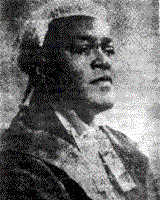 colonial era. A brilliant lawyer, Sir Ernest, who later became a judge,
was also an outspoken and popular politician.
colonial era. A brilliant lawyer, Sir Ernest, who later became a judge,
was also an outspoken and popular politician.
Sir Ernest was born on March 15, 1895 in Freetown, in the Crown Colony
of Sierra Leone. He was educated at the Leopold Educational Institute,
Fourah Bay College (Durham University), and University of London. He was
called to the Bar in 1917. Alongside his legal practice, Sir Ernest devoted
a lot of his time to civic matters, serving first as member of the Freetown
City Council and then as mayor (1925-1926). As a mayor, he did much to
secure the general improvement of the city and the reorganisation of the
Freetown City Council. Sir Ernest was one of the first three Africans to
be elected in 1924 to the Legislative Council, and he served as the first
Urban Member.
In 1937, Sir Ernest quit politics for the bench and was appointed police
magistrate. Later, he became the first Sierra Leonean Puisne Judge
(1945), the first Sierra Leonean West Africa Court of Appeal Judge (1946),
and the first Sierra Leonean Vice-President of the Legislative Council
(1953). He was awarded a knighthood by Queen Elizabeth in 1957, the second
national to be so honoured. He died the same year.
Sir Ernest is best remembered for the many legal laurels he won for
Sierra Leone during the colonial period. He was a dedicated nationalist
who also served in most of the constitutional committees before independence.
ISAAC THEOPHILUS AKUNA WALLACE-JOHNSON
(1894-1965)
TRADE UNIONIST AND NATIONALIST LEADER
I. T. A. Wallace-Johnson led the first mass movement of Sierra Leoneans
from all walks of life, working untiringly for unity and the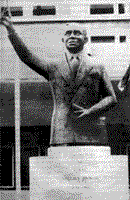 rights of the common man.
rights of the common man.
He was born into a poor Krio family in Wilberforce Village and attended
mission schools. At the age of eighteen, he entered government service
as a customs clerk, but was soon dismissed for helping to organise the
first trade union in Sierra Leone. After serving as a clerk in the Carrier
Corps, he joined the merchant marine as a common sailor, later editing
a newspaper in London dedicated to promoting the welfare of seamen. In
1931, Wallace-Johnson founded the first labour union in Nigeria, and in
1936 he was jailed in the Gold Coast (Ghana) for publishing a scathing
attack on colonialism.
He returned to Sierra Leone in 1938 and, within a year, had organised
eight labour unions, a newspaper, and a mass political movement that swept
aside all opposition in the city council elections. His West African Youth
League was dedicated to greater popular representation in government, an
expanded civic role for women, improved salaries and conditions for workers,
and national unity among all Sierra Leoneans. Wallace-Johnson taunted the
colonial authorities by making public certain secret documents showing
the governor's agreement to painfully lower salaries for working people.
British officials tried to prosecute Wallace-Johnson, but no local jury
would convict him, and at one point, eighteen of Freetown's twenty-one
lawyers were members of his Youth League. Moreover, Wallace-Johnson was
personally popular and a likeable man with an excellent sense of humour,
who once told a group of workers, "I am not anything above you; I am at
par with you."
But the colonial authorities finally jailed Wallace-Johnson in 1939
under an Emergency Act adopted at the outset of World War II. He was ultimately
exiled to Sherbro Island, where he spent most of his time teaching the
local people how to read and write. Wallace-Johnson lived to become one
of Sierra Leone's delegates to the London Independence Talks in 1960. He
will long be remembered as an ardent patriot and a true man of the people.
CONSTANCE AGATHA CUMMINGS-JOHN
(1818-)
A WOMAN OF INDEPENDENCE
Mrs. Cummings-John's strong commitment to the ideals of justice and
fairplay was demonstrated by her active participation in the 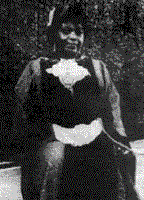 political struggle for national emancipation.
political struggle for national emancipation.
As a woman, her struggle was two-fold: untying the knot of colonialism,
and gaining acceptance in a western-influenced Sierra Leone Colony where
women were not usually expected to engage in political activities.
Born into a prominent Krio family in 1918, it was perhaps inevitable
that she should be interested in politics, since her family was so much
involved in community affairs and local business.
The young Constance received her early education in Freetown: Annie
Walsh Memorial School, Methodist Girls' High School and Freetown Secondary
School for Girls. She proceeded to England at the age of seventeen and
entered Whitelands College in Putney, where she trained as a teacher. In
London, she also found time to participate in the activities of two Pan-African
Organisations, the West African Students' Union (WASU) and the League of
Coloured Peoples (LCP). Both were pressure groups fighting the African
cause.
In 1936 she went to the United States to do a six-month course at Cornell
University. It was a shocking experience. The racial insults heaped on
her and the lack of understanding from Afro-Americans affected her political
consciousness profoundly. Depressed but undaunted, she resolved to return
home and "throw the whiteman out." In 1937, she married Ethanan Cummings-John,
a lawyer, and the same year saw them return to Sierra Leone.
In Freetown, she took up appointment as Principal of the A.M.E. Girls'
Vocational School. She found the school in a dilapidated state, and immediately
embarked on a fund-raising campaign to make improvements. Through this
venture, she pioneered the construction of a new domestic science building
with modern equipment.
When I.T.A. Wallace-Johnson returned to Sierra Leone in April 1938,
she immediately joined forces with him in the establishment of a "chapter"
o the West African Youth League (WAYL). The move was a resounding success,
for in the Municipal Council elections in November 1938, the WAYL candidates
swept the polls. Mrs. Cummings-John received the highest number of
votes of any candidate. As councillor, Mrs. Cummings-John was mainly concerned
with the improvement of city services, particularly sanitation, library
facilities and conditions in city markets.
In recognition of the importance of women in community affairs, she
established a network of leading market women; in 1951, with their support,
she established the Sierra Leone Women's Movement, which played a leading
role in the struggle for self-government.
After independence, Mrs. Constance Cummings-John became the first woman
mayor of the Freetown Municipality.
EMMANUEL COLE
(1908-1972)
HERO OF THE "GUNNERS' REVOLT"
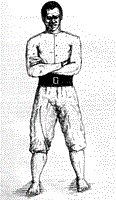 Emmanuel
Cole was an ordinary soldier who demanded fair treatment and reasonable
pay from the colonial power. Emmanuel
Cole was an ordinary soldier who demanded fair treatment and reasonable
pay from the colonial power.
He was a gunner attached to the Royal Artillery at the heavy battery
in Murray Town Barracks. In January, 1939, Cole convinced a group of his
fellow gunners to join him in sending a letter of protest the their British
commanding officer, complaining that their meagre pay was not enough to
meet expenses and British officers were secretly pocketing a portion of
it. Cole and his fellow gunners also demanded to be treated in the same
way as British soldiers of the same rank; and, most of all, they demanded
boots or some sort of footwear as part of their uniform.
The Inspector-General of the West African Frontier Force had recommended
boots for the soldiers as early as 1903, but the British officers on the
sport preferred the African soldiers to remain barefoot to suggest their
inferiority to British troops. When the commanding officer ridiculed the
soldiers' demands, Cole asked bluntly: "Is our flesh different from that
of the white gunners?," and when their demands received no consideration,
Cole organised a strike. They refused to dress properly or to come to parade
until given a fair hearing.
The British decided to deal with Cole and the others in the harshest
possible way, and they charged them with "mutiny," a crime carrying severe
punishment under the military code. Throughout the court martial proceedings,
Emmanuel Cole was coolly defiant. The British authorities had found receipts
for dues to I.T.A. Wallace-Johnson's Youth League in his quarters, and
hoped to pin the supposed "mutiny" on Wallace-Johnson. When asked if he
knew the great union organiser, Cole would only say: "Yes, he is a man."
The British officers sentenced Emmanuel Cole to fifteen years in prison
and his fellow gunneers to period ranging down to eighty-four days, but
Labour MPs in Britain agitated until Cole and the others were pardoned.
Soon after the so-called "mutiny," the British were finally forced to
provide boots and improved conditions of service to their troops in Sierra
Leone and throughout British West Africa.. Emmanuel Cole's efforts had
brought increased dignity to many thousands of his fellow Africans.
ASANA BEYA
(1915-1987)
DISTINGUISHED SOLDIER
Asana Beya was a soldier whose leadership qualities and outstanding
courage earned him a Distinguished Conduct Medal (DCM) in the Second World
War.
Born at Rotifunk village in the Maforki Chiefdom, Port Loko District,
Asana Beya enlisted in the army some years before outbreak of the Second
World War. When the war broke out, his battalion was posted to the South-East
Asian (Burmese) war front. Before long, the leader of the battalion, Lt.
Col. H.M. Boxer, recognised Beya's leadership qualities and recommended
his promotion to the rank of Lance/Corporal. Beya acquitted himself so
well that he earned further promotions and by 1944, he had risen to the
position of Sergeant.
It was as a sergeant and as defence platoon commander that Beya led
an action against a Japanese force of one platoon in the Kaladan region
of Western Burma, routing the enemy and capturing documents which provided
the Allied Forces with very valuable information. The memorable encounter
is reported in detail in Volume I of the Regimental History thus:
"On December 22, 1944, 2 companies occupied Point 887 Thandada at last
light, and had consolidated during darkness. At approximately 05.30 hours
23 December 1944, a Japanese force of one platoon penetrated the positions
from the rear in the vicinity of Battalion Headquarters which was protected
by 2 sections of the Defence Platoon commanded by Sgt. Asana Beya. There
had not been time to dig defensive positions but Sgt. Asana Beya took immediate
action and organised his platoon to meet the attack. In the early stages,
oblivious of the fire, he continually visited his men and encouraged them.
When it became apparent that the enemy were on the point of overrunning
his position, he seized an LMG and advanced towards the enemy, entirely
regardless of the heavy fire directed against him. He showed a complete
disregard for his own safety, and firing from the hip as he advanced, personally
killed 6 of the enemy, before the remainder turned and fled. His leadership
was an inspiration to all around him, and it was largely due to his courage,
initiative and resolution, that the attack was finally beaten off and the
action brought to a successful conclusion. Through his action, many valuable
documents giving enemy strength and dispositions were captured. Among the
enemy killed was one Japanese officer. Sgt. Beya was awarded an immediate
DCM."
When Asana Beya died in 1987, His Excellency Major-General Dr. J. S.
Momoh directed that he be accorded full military honours on the occasion
of the ceremonies relating to the 40th day of his death. A three mile long
access road leading to his village was constructed, and this made possible
the presence of a military detachment as well as representatives of the
Sierra Leone Ex-Servicemen's Association. National and state recognition
of Beya's unforgettable military exploits was demonstrated by the gracing
presence of President Momoh himself.
HAIDARA KONTORFILLI
(ca. 1890-1931)
CHARISMATIC RELIGIOUS LEADER
Haidara Kontorfilli was a charismatic Islamic religious reformer and
an anti-colonialist who championed the cause of the rural masses.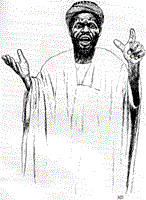
His surname derives from a Mandingo word which could be freely translated
as meaning an enigma, or a thorn in the flesh. It is possible that this
was not Haidara's original surname, and represented popular recognition
of the challenge he posed to the colonial government.
Haidara entered Sierra Leone from the then French colony of Guinea in
May, 1930 and settled in Bubuya in the Kambia District, where he healed
the sick, and from where he disseminated his religious teachings. His influence
spread quickly and widely, and he attracted a considerable following. He
stressed the need for religious reform, directing his teachings mainly
to the poorer peasants, and acting as the guardian of their interests.
He distinguished between believers and infidels and, in a letter to the
District Commissioner, Kambia District, warned the latter to change their
ways and convert to Islam or face death.
At this juncture, the colonial administration became alarmed and confused,
seeing his teachings and pronouncements as a threat to the stability of
the government. On February 9, 1931, the colonial administration served
Haidara with an expulsion order, charging him with sedition. Haidara ignored
the order and, in reply, wrote an open letter to the people of Kambia which
among other things told them not to fear the Europeans, whether French
or English, and to refrain from paying the hated house tax, a proposal
which made plenty of sense to the peasant masses hard pressed by the raging
economic depression at the time. In effect, the letter was an open challenge
to the very foundation of the colonial regime, and amounted to a declaration
of war against it. The reaction of the colonial administration was to despatch
troops of the Royal Wes t African Frontier Force stationed in Kambia to
effect Haidara's arrest at Bubuya.
Haidara, determined not to submit to the humiliation of an arrest, proceeded
to organise and arm his followers with machetes, swords and guns in readiness
for the inevitable encounter. The confrontation which took place on February
16, 1931 was brief. Haidara succeeded in killing the commanding British
officer but he and four of his men were killed almost instantly, and the
other protesters were dispersed.
Haidara Kontorfilli was clearly a heroic and charismatic leader, courageous
and invested with considerable organisational abilities. His commitment
to his own ideas and beliefs as well as to the interest of his followers
was unquestionable, and in the end he sacrificed his life for both.
KISIMI KAMARA
(ca. 1890-1962)
INVENTOR OF MENDE WRITING
Kisimi Kamara was a simple village tailor who gave his people the gift
of writing.
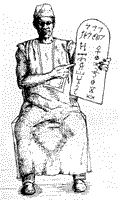 He
was born in Vaama, near Potoru, in Pujehun District, a descendant of Mandinka
people who had lived long in Mende country. Kisimi had no formal education
other than some training in Arabic under the local Karamoko, but
his fellow villagers knew him as a man of unusual intelligence and energy.
Kisimi had seen how the British had taken over the country and subjected
the chiefs to their will. He felt that the white man's power derived, to
some extent, from his ability to read and write, and he vowed that his
own Mende people should have the same ability. He
was born in Vaama, near Potoru, in Pujehun District, a descendant of Mandinka
people who had lived long in Mende country. Kisimi had no formal education
other than some training in Arabic under the local Karamoko, but
his fellow villagers knew him as a man of unusual intelligence and energy.
Kisimi had seen how the British had taken over the country and subjected
the chiefs to their will. He felt that the white man's power derived, to
some extent, from his ability to read and write, and he vowed that his
own Mende people should have the same ability.
In 1921, Kisimi was inspired by a dream or vision. He shut himself up
alone in his house for ten weeks, and then emerged with a fully complete
system of writing. He had developed what linguists call a syllabary, a
set of characters representing consonant-vowel combinations. Kisimi called
his new writing "Ki-ka-ku" for the first three letters in a system containing
a total of 195 symbols. He devised a method for teaching Ki-ka-ku, and
opened a school at Potoru. During the 1920s and 1930s, Kisimi Kamara became
a famous man in the Mende country, as many people learned to read and write
in this Ki-ka-ku system. His writing became popular for record-keeping
and correspondence, and some chiefdom clerks adopted it for official use.
But, in the 1940s, the British established the Protectorate Literacy
Bureau in Bo which began teaching people to read and write Mende in a modified
version of the European, or Latin, alphabet. Kisimi Kamara's system of
writing gradually fell into disuse and was forgotten, and in his later
years Kisimi was disappointed that his system had been abandoned.
He died in 1962 and was buried in his home town of Vaama. Kisimi's brilliant
invention was destroyed by colonialism, but his work inspired among his
people a pride in their native language and a determination to develop
it to its full potential.
SIR MILTON AUGUSTUS STRIEBY
MARGAI
(1895-1964)
ARCHITECT OF SIERRA LEONE INDEPENDENCE AND FIRST PRIME MINISTER
Sir Milton Margai was born in Gbangabatoke in what is now Banta Chiefdom,
Moyamba District, on December 7, 1895. The eldest son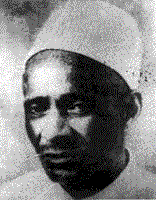 of the prominent businessman, Mr. M.E.S. Margai of Bonthe, he received
primary and secondary education at the E.U.B. school, Bonthe, and the Albert
Academy in Freetown, respectively. In 1921, he obtained his B.A. degree
from Fourah Bay College. He then went to Britain where he obtained an M.A.
degree and studied medicine at King's College, Durham, graduating in 1926.
of the prominent businessman, Mr. M.E.S. Margai of Bonthe, he received
primary and secondary education at the E.U.B. school, Bonthe, and the Albert
Academy in Freetown, respectively. In 1921, he obtained his B.A. degree
from Fourah Bay College. He then went to Britain where he obtained an M.A.
degree and studied medicine at King's College, Durham, graduating in 1926.
Sir Milton had a string of firsts to his name: first Protectorate man
to graduate from Fourah Bay College, first Protectorate man to qualify
as a medical doctor, founder of the first Protectorate newspaper (the Sierra
Leone Observer), Sierra Leone's first Chief Minister, Prime Minister and
Privy Councillor.
He was a distinguished member of the Colonial Medical Service who pioneered
social welfare and hygiene education in remote areas of the Protectorate.
He encouraged leaders of the Mende women's secret society, the Sande, to
include training courses in hygiene, literacy and childcare in their programme
of initiation for young girls. These courses were taught by qualified instructors,
most of whom were trained by Sir Milton himself.
In 1950, Sir Milton retired from the government medical service and
set up private practice. As a result, he had more time to devote to politics.
He was from the very beginning an active member of the Protectorate Educational
Progressive Union (PEPU) which later merged with the Sierra Leone Organisation
Society (SOS) to form the Sierra Leone People's Party (SLPP) of which he
became the first national chairman. After the 1951 elections, he became
Leader of Government Business, and in 1954, Chief Minister.
In politics, Sir Milton was the consummate negotiator and a skilful
strategist. At the time he entered politics, Sierra Leone was divided into
Colony and Protectorate with separate and different political systems.
Antagonism between the two entities came to a head in 1947 when proposals
were introduced to provide for a single political system for both the Colony
and the Protectorate, with an unofficial African majority in the
Legislative Council, most of whom were to come from the Protectorate. The
Creoles of the Colony naturally opposed the proposals whose effect would
have been to diminish their political power. Joining the Creoles in opposition
to some aspects of the proposals, however, were the educated elite of the
Protectorate who saw in the proposals a means of transferring the dominant
position of the chiefs from the Protectorate Assembly to the Legislative
Council. It was due to the astute politics of Sir Milton that the younger,
educated Protectorate elite were won over to join forces with the chiefs
in the face of Creole intransigence. Later, Sir Milton was to use the same
skills to win over opposition leaders and moderate Creole elements to his
United Front government for the achievement of independence. He offered
top ministerial positions within the SLPP cabinet to such opposition leaders
as Albert Margai, who had earlier broken away from the SLPP to form the
PNP; C.B. Rogers-Wright, leader of the main surviving Creole party, the
UPP; and G. Dickson-Thomas, leader of the IPP, a splinter of the UPP. As
a result of this, the leaders agreed to disband their parties to serve
under the banner of the SLPP.
An important aspect of Sir Milton's character was his self-effacement.
He was neither corrupt nor did he make a lavish display of his power or
status. Although he was conservative, he was tolerant of his opponents,
and was not one to insist on having his way all the time. These qualities
endeared him to all Sierra Leoneans who loved, respected and admired him.
Many Sierra Leoneans look back to the age of "Pa," as he was fondly known,
as one of the almost idyllic stability, and there can be no doubt that
Sir Milton left deep and indelible footprints on the sands of time.
SIR ALBERT MICHAEL MARGAI
(1910-1980)
SECOND PRIME MINISTER
Sir Albert was born on October 10, 1910, at Gbangbatoke, Banta Chiefdom
(now in the Moyamba District) and was educated at St.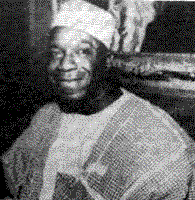 Edward's Secondary School, Freetown.
Edward's Secondary School, Freetown.
He first worked as a nurse from 1931 to 1944, then proceeded to Britain
to study law at the Inner Temple Inns of Court where he qualified in 1948.
He returned to Sierra Leone and enrolled as a solicitor and advocate in
the Supreme Court and set up private practice.
Sir Albert played an active role in the debates over the Stevenson Constitution
and was one of the chief spokesmen for protectorate interests. He held
cabinet positions in Education, Agriculture, Natural Resources and
Finance between 1951 and 1964. In 1951, he was elected to the Legislative
Council as the first Protectorate Member, and became the first Minister
of Education when he was appointed to the cabinet in 1952. In 1957, he
was returned to parliament in the general elections as M.P. for Moyamba
South Constituency. Shortly after the elections, he challenged his brother
for the leadership of the party and was elected leader of the S.L.P.P.
but later stepped down for his elder brother after he had been guaranteed
that his closest ally, Siaka Stevens, would return to the cabinet. It was
Sir Milton's failure to honour this and other pledges that led Albert to
refuse the cabinet position he had been offered, and to form his own party,
called People's National Party, in September 1958. He was appointed Minister
of Agriculture in the United Front Coalition in 1959. In 1962, he was returned
as M.P. for Moyamba South Constituency and was appointed Minister of Finance.
He introduced the decimal currency, established the "leone" as legal tender,
and created the Bank of Sierra Leone as our Central Bank. He became Prime
Minister on April 29, 1964, following the death of Sir Milton.
At the time he became leader of the S.L.P.P. and Head of Government,
Sir Albert was no longer a young man, but he did not enjoy the reverence
which old age had bestowed upon his elder brother. As the first up-country
lawyer, he was highly respected but, unlike Sir Milton, did not enjoy the
support and confidence of all factions of his party. As the recognised
leader of the progressive wing of the S.L.P.P., he advocated a faster pace
of development for Sierra Leone and took an "African" stand on most international
issues. Sir Albert was also known to have advocated less attachment to
traditional institutions, and while he was leader of the People's National
Party (PNP), he openly asked traditional rulers to stay out of politics.
As Prime Minister, Sir Albert, who had come to be popularly known as
"Big Albert," "Albert of Africa," and "Akpata," infused dynamism and glamour
into the somewhat sedate politics of Sierra Leone.
He had great respect and admiration for Presidents Sekou Toure and Kwame
Nkrumah, and sought to emulate the two leaders in their stands on international
issues and their preoccupation with politicising the mass of their people.
Sir Albert personified the African personality both in his attire and his
public utterances on African issues..
Until he came on the scene, S.L.P..P. politics was largely a conservative
affair left to chiefs, elders and opinion leaders. Sir Albert added glamour
by increasing pomp and pageantry in the office of Prime Minister. Outriders
on motorcycles and police landrovers with blaring sirens became more conspicuous.
Gaily attired women in ashobi, young men in party t-shirts, praise singers
and drummers also became a regular feature of the political scene. With
the introduction of the institution of Mammy Queens, women suddenly became
important in politics, organising their fellow women in sections to provide
political support for the leadership..
In his attempt to project himself as a symbol of national unity and
as catalyst for mobilising the progressive forces of the country, Sir Albert
found himself in the same dilemma in which many African leaders of his
time found themselves. His impatience with the gradualism of the older
generation, and his revolt against their authority, not only alienated
him from a section that still had considerable sway, but also opened him
to attacks from younger elements who perceived his efforts as not going
far enough.
Racked by accusations of corruption in high places and of disregard
for the interests of significant sectors of the population, Sir Albert
lost the 1967 elections to the opposition A.P.C., and in the process became
the first and only leader of an African state to have officially
lost an election.
In spite of the failings of his regime, this genial giant who was wont
to threaten to shoot down his opponents, brrr...had profound respect for
the law and the constitution of the land. He relied on legal rather than
extra-legal means in his fight against his opponents, and in the process
helped to preserve a sacred heritage.
EUSTACE HENRY TAYLOR CUMMINGS
(1890-1967)
PUBLIC SERVANT AND CONCERNED CITIZEN
Eustace Taylor-Cummings was Mayor of Freetown from 1948 to 1954. His
contribution to the medical service as a doctor, to civic 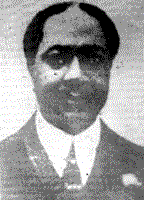 duties as mayor, and to fostering education in Sierra Leone is an example
worthy of emulation.
duties as mayor, and to fostering education in Sierra Leone is an example
worthy of emulation.
Eustace was born the son of a leading Krio merchant, Emmanuel Cummings,
who had himself been Mayor of Freetown. As would be expected from this
background, he had the opportunity of the best education that could be
offered in Sierra Leone at the time. He attended the Wesleyan Boys High
School (now Methodist Boys' High School) and, from 1909 to 1911, studied
at Fourah Bay College. He then proceeded to Britain, where he became the
first African to qualify as a doctor from the University of Liverpool.
After working in Birmingham as a doctor for a short while, he returned
home in 1920 and joined the medical service. Those were the days when European
doctors did not care to serve under a black doctor, and many resigned rather
than accept this. Eustace Cummings was first attached to the Sanitation
Department. In that position, he made an extensive tour of the protectorate.
He also worked to improve the sanitary conditions of Freetown in particular
and the colony in general, advocating a proper drainage system and proper
ventilation in houses. By the time of his retirement in 1947, he had risen
to the rank of Senior Medical Officer.
Eustace Cummings was also very active in civic affairs in Freetown,
achieving the position of Mayor of Freetown in 1948. He first joined the
Freetown City Council as nominated member in 1936, and held this position
until he became mayor. As mayor, he was instrumental in establishing the
system which has now become the municipal schools in Freetown, starting
with the Interim Municipal (now Regent Square) School.. He also successfully
pressed the colonial government to build these new schools in Freetown.
Eustace Cummings was a member of the Commission on Higher Education
in West Africa, appointed by the British government in 1943. This commission's
report resulted in the establishment of the University Colleges of Ibadan
and the Gold Coast. Cummings recommended that Fourah Bay College be retained
for the time being as a college of Durham University and then be allowed
to develop as an autonomous university, which turned out to be precisely
the way things developed.
When the colonial government threatened to reduce the status of Fourah
Bay College to that of a technical college in 1944, Cummings was one of
the concerned citizens who formed the "Save the Fourah Bay College" Committee
to mobilise popular support against the move.
From 1950 to 1953, Cummings was President of the Fourah Bay College
Council, the governing body of the college, being the first Sierra Leonean
to hold that position. In 1960, he was awarded the Doctor of Civil Laws
by Durham University in England. He lived a very upright life as an active
churchman, and died in 1967.
LAMINA SANKOH
(1884-1964)
CHAMPION OF INTEGRATION
Ethelred National Jones was born at Gloucester in the Mountain District
of Freetown on June 28th, 1884. From the 1920s onwards, he 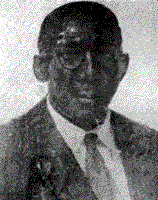 used the name Lamina Sankoh. He was one of the most prominent and fearless
leaders in pre-independence Sierra Leone, and one of those most dedicated
to the unification of colony and protectorate. An astute politician, he
founded one of the first political parties, the Peoples Party, in 1948.
He was also a radical churchman, and a political writer, analyst and educator.
used the name Lamina Sankoh. He was one of the most prominent and fearless
leaders in pre-independence Sierra Leone, and one of those most dedicated
to the unification of colony and protectorate. An astute politician, he
founded one of the first political parties, the Peoples Party, in 1948.
He was also a radical churchman, and a political writer, analyst and educator.
He was educated at the village school at Gloucester, the Cathedral School,
Albert Academy and the C.M.S. Grammar School. He went to Fourah Bay College
where he graduated with a B.A. He entered Wycliffe College, Oxford, where
he read Theology and Philosophy.
Lamina Sankoh returned home in 1924, but his relations with the church
were not so cordial because of his controversial sermons. He was ordained
a priest and appointed curate of Holy Trinity Church, a post he held until
1927. During his curacy, he also lectured Logic at Fourah Bay College.
He was dissatisfied with the lack of progressive thinking in the Church
in Sierra Leone. He therefore resigned his curacy and again proceeded to
Britain where he read Education at Oxford. A year later, he travelled to
the United States where he taught at Tuskegee Institute at Alabama, Lincoln
University in Pennsylvania and the State College at Orangeburg, South Carolina.
In 1930 he went back to Britain where he was active in the West African
Students Union (WASU), a political pressure group agitating for self-government.
He was a regular contributor to the WASU Journal, of which he later became
editor.
He returned to Sierra Leone in the early 1940s, and he immediately embarked
on political and civic activities.. He was at the same time untiringly
involved in settling the political conflict between colony and protectorate.
He took an active role in the reconstruction of the Freetown City Council
and was elected a councillor for the Central Ward in 1948. He taught courses
at the Extra-Mural Department of F.B.C. and was at one time President of
the Freetown Adult Education Society. He founded the Sierra Leone ARO (Co-Operative)
Society and established a Penny Savings Bank for his supporters. In 1948,
he started a newspaper in Freetown called "The African Vanguard."
He established an African church where theology and philosophy were relatively
free of Western influences.
It was however in national politics that this competent political philosopher
made his most lasting impact. He founded the (People's) Forum, a cultural
organisation intended to examine the values held by Sierra Leoneans. When
almost the entire colony was misguided enough to uphold the idea of a "united
country based on segregation and prescriptive rights," this colony-born
man had the courage to stand by his conviction that Sierra Leone was one
country, and that its inhabitants should live and work as one. He merged
his People's Party with the Sierra Leone Organisation Society and, through
the merger, the S.L.P.P. was born. He also transferred ownership of The
African Vanguard to the new party.
Lamina Sankoh was a popular and dedicated nationalist who, with other
men of his time, introduced intellectualism into Sierra Leone politics.
His untiring efforts to unite colony and protectorate, for which he is
always fondly remembered, constitute a significant contribution to the
process of national integration.
JOHN KAREFA-SMART
(1915)
LEADING POLITICIAN AND INTELLECTUAL
John Karefa-Smart was born at Rotifunk, Bumpe Chiefdom in what is now
Moyamba District. He is one of Sierra Leone's most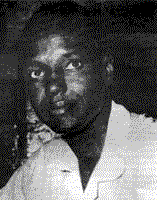 articulate politicians.
articulate politicians.
He was educated at the E.U.B. Primary School, Rotifunk, the Albert Academy,
and then Fourah Bay College. Later, he went to Otterbein College in the
United States and McGill University in Canada. In the course of this academic
activity, he acquired the degrees of B.A., M.Sc., C.M., D.T.M. He worked
in various parts of the world, and was Regional Medical Officer for the
West Africa Region of the World Health Organisation.
Dr. John Karefa-Smart entered politics in 1957. He was a foundation
member of the Sierra Leone Organisation Society, which later became the
S.L.P.P. He was active in the constitutional committees that eventually
led to Sierra Leone's independence in 1961. In 1957, he was appointed Minister
of Lands, Mines and Labour with special responsibilities for Defence. After
the 1962 elections, Dr. John Karefa-Smart was appointed Minister of External
Affairs, a position which he used to foster the good image of the young
nation. It was in his term of office as Minister of External Affairs that
Sierra Leone established diplomatic relations with several countries.
Dr. John Karefa-Smart is known in Sierra Leone as a politician rather
than as a medical doctor — which is actually his profession.
This was because he devoted most of his time to the nationalist struggle.
He will be remembered for the intellectual vigour which he introduced into
the politics of Sierra Leone.
KANDE BUREH
(1908)
PROMINENT POLITICAL FIGURE
Kande Bureh was born Saidu Bai Kamara in 1908 at Mange Bureh in what
is now Port Loko District, Northern Province. He started his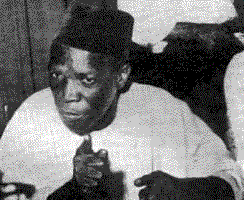 primary education at the A.M.E. School, Mange, and also learnt Arabic through
the articulate Arabic scholar, Santigie Rembu. In 1920, Kande Bureh left
his native home of Mange to settle in Freetown, where he attended the Methodist
Boys' High School and later qualified as a teacher..
primary education at the A.M.E. School, Mange, and also learnt Arabic through
the articulate Arabic scholar, Santigie Rembu. In 1920, Kande Bureh left
his native home of Mange to settle in Freetown, where he attended the Methodist
Boys' High School and later qualified as a teacher..
His abiding desire to educate the young and prepare them for a better
future, and his unquenchable urge to spread knowledge far and wide, saw
Kande Bureh serving as a teacher for well over fifteen years. He taught
at the Bethel Primary School at Kossoh Town, Freetown; later he moved to
the Ebenezer Amalgamated School and then to the Madrassa Islamia.
He left the teaching field in 1945 and was elected Tribal Headman for
the Temne community in Freetown. At this stage in his life, Kande Bureh
wanted to do more work for his people. His major task, and one which
he successfully accomplished, was to bring about a closer relationship
between the various ethnic groups. He worked amicably with other tribal
leaders and, in his desire to foster participation and integration in Sierra
Leone, founded several friendly societies such as Murkaramin, the now legendary
Ambas Geda, and the Temne Progressive Union. Through these various organisations,
over eleven mosques were built to cater to the religious needs of his people.
The mosques were also utilised as "barries" where people met and discussed
social and political issues. Thus Kande Bureh started a development which
contributed to the enlightenment of his countrymen in the drive towards
independence. He sponsored the Ahmadiyya Muslim Movement in Freetown and
also helped the Movement secure lands at Rokupr, Bo, Boajibu and several
other towns in the provinces.
Kande Bureh eventually entered national politics. He joined the Sierra
Leone Organisation Society (SOS) formed by the protectorate elite. In mid-1951,
the SOS which, until then, was essentially an instrument for educational
advancement in the protectorate, was dissolved and in its place, a political
party, the Sierra Leone People's Party (SLPP), was formed. Following elections
in 1957, in which the SLPP emerged as the victorious party, Kande Bureh
was appointed Minister of Works and Housing. After the 1962 elections,
he became Minister of Transport and Communications and, on several
occasions, acted as Prime Minister.
Kande Bureh is a prominent member of that great generation of leaders
from the then protectorate who guided the transition from colonial rule
to national independence.
AMADU WURIE
(1898-1977)
DEDICATED EDUCATIONIST
Alhaji Amadu Wurie was one of Sierra Leone's foremost educators in the
20th century. An active politician, he was appointed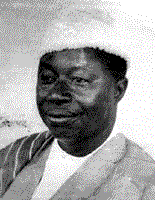 Minister of Education in the first post-independence Sierra Leone government.
Minister of Education in the first post-independence Sierra Leone government.
He was born in Gbinti on the estuary of the Melacourie River. His father,
Paramount Chief Bai Sheka Bundu, was one of the principal supporters of
Bai Bureh during the 1898 uprising against the British.
Amadu Wurie was a foundation pupil of the Bo School in the Southern
Province, established in 1906 to cater for the education of sons and nominees
of chiefs. In 1916, he was among the first pupils of that school to succeed
to the Civil Service Entrance Examination. He was appointed an Assistant
Master at the school in 1916, subsequently rising to the rank of Senior
Assistant Master in 1925. In 1927 he suggested the formation of the Old
Bo Boys' Association (O.B.B.A.), serving first as general secretary and
later as president of this organisation which was the inspiration for many
other old boys' clubs in the country. On several occasions between 1933
and 1935 Amadu Wurie served as Acting Principal of the school, the first
African to fulfill such a role.
From Bo, he moved on to Koyeima School, Bo District, where he served
as headmaster from 1935 to 1942. In the latter year, he became Education
Officer, a post he held until 1952 when he was appointed the first principal
of the Kenema Secondary School. In 1953, he was appointed a member of the
Port Loko District Council and Chairman of the Port Loko Education Authority.
In 1955, he was appointed Provincial Education Secretary, Northern Province.
Six years later, he became a member of the Mine Workers' Wages Board.
By 1961, when Sierra Leone became independent, Amadu Wurie had served
in most of the districts in the country.. His connection with the country's
leading political figures dated from his Bo School days. As early as the
late 1940s, he had become an active member of the Protectorate Educational
Progressive Union (P.E.P.U.), which then comprised most of the protectorate
elite. In 1962, he entered parliament under the Sierra Leone People's Party
(S.L.P.P.) banner and was appointed Minister of Education in recognition
of his life-long devotion to teaching. After the cabinet crisis following
Albert Margai's appointment as prime minister in 1964, Amadu Wurie was
one of the few prominent northern ministers loyal to the new head of government.
He later served as Minister of the Interior.. In 1964 he was awarded the
C.B.E. (Companion of the British Empire) for his significant contribution
to the educational progress of the country.
After the 1967 general election, in which he lost his seat, Amadu Wurie
retired into private life at Mahera, near Lungi, in the Port Loko District.
During this period, he made a pilgrimage to Mecca. In January 1973, the
University of Sierra Leone conferred on him the honorary degree of Doctor
of Civil Laws.
Besides politics, Amadu Wurie also took a lively interest in the history
of the country, especially that of his Fula ancestors, the Bunduka, in
whose territory he collected many oral traditions. These were published
in the Journal, Sierra Leone Studies. While in retirement, he co-authored
(with Elizabeth Hirst) a biography of his grandfather, Alimamy Rassin,
which was published in 1968.
He died on June 13, 1977.
ELLA KOBLO GULAMA
(1921-)
PARAMOUNT CHIEF AND NATIONAL POLITICIAN
The introduction of party politics in Sierra Leone ushered in the active
participation of women in national affairs. Although their 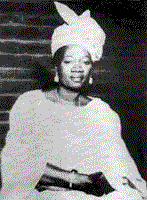 number was small, the few that ventured into politics became very prominent.
One such notable woman has been Ex-Paramount Chief Madam Ella Koblo Gulama.
number was small, the few that ventured into politics became very prominent.
One such notable woman has been Ex-Paramount Chief Madam Ella Koblo Gulama.
Madam Ella, as she is fondly called, succeeded her late illustrious
father, Julius Gulama, as Paramount Chief of Kaiyamba Chiefdom, Moyamba
District, in 1953. Thereafter, she became actively involved in national
politics with the support and encouragement of Sir Milton Margai and Sir
Albert Margai. She became a member of the Moyamba District Council and
was elected to the House of Representatives in 1957 — the
first ever woman member of that august body. She was re-elected to parliament
in May, 1962 and appointed the first woman cabinet minister.
She became a close ally of both Sir Milton and Sir Albert. But it was
essentially during the brief period of Sir Albert's premiership that she
gained a reputation as one of the most powerful members of the government.
This pioneer of women's liberation in modern Sierra Leone politics went
into temporary political limbo after Sir Albert's fall from power, before
bouncing back as an APC stalwart and leader of the Moyamba District APC
Women's Organisation in the early 1970s.
Born in 1921 at Moyamba, Ella was educated at the Harford School for
Girls, and the Women Teacher's College, then at Wilberforce. Although she
ruled a predominantly Mende chiefdom, Ella Koblo married a powerful Temne
paramount chief from the north of Sierra Leone, Ex-Paramount Chief Bai
Koblo Pathbana, in 1946. This association may have contributed to the process
of national integration.
All who get to know Madam Ella Koblo Gulama for even a brief period
are fascinated by her charm, engaging presence and public spiritedness.
She is undoubtedly one of the most colourful and resourceful women national
figures who have contributed to the political development of Sierra Leone.
SIR BANJA TEJAN-SIE
(1917-)
SECOND GOVERNOR-GENERAL
Sir Banja Tejan-Sie, one of Sierra Leone's most prominent politicians
during the colonial and post-colonial periods, was born on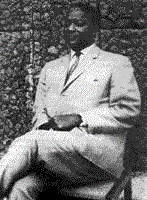 August 7th 1917 at Moyamba, in what is today the Southern Province of Sierra
Leone.
August 7th 1917 at Moyamba, in what is today the Southern Province of Sierra
Leone.
He was educated at the Bo Government Secondary School and the Prince
of Wales School. Before proceeding for further studies, he worked as a
station clerk in the Sierra Leone Railway from 1938 to 1939 and as a nurse
in the Medical Department from 1940 to 1946. He went to Britain and studied
at the London School of Economics, and at Lincoln's Inn, where he was subsequently
called to the Bar in 1951.
Sir Banja returned home and set up private practice. He also became
involved in politics, and was one of those who agitated for an end to colonial
rule. Sir Banja was a prominent member of the Sierra Leone People's Party
from its inception, and was elected vice-president of the party in 1955.
In 1958, he was appointed Police Magistrate, but he continued to be quite
active in politics, and was a member of the Independence Constitutional
Committee. In 1967, he was appointed Chief Justice and, in April 1968,
he was appointed officer performing the functions of the Governor-General.
Sir Banja Tejan-Sie quit politics in the wake of the introduction of
the Republican Constitution in 1971 and retired to London. In April 1987,
he visited Sierra Leone, heeding President Momoh's call for national reconciliation.
MOHAMMAD SANUSI MUSTAPHA
(1903-)
DEDICATED MUSLIM, BUSINESSMAN,AND POLITICAL LEADER
Alhaji Mohammad Sanusi Mustapha has made lasting contributions in the
fields of Islam, education, commerce, and politics. And, 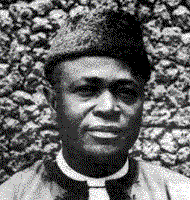 indeed, he stands in a long and proud tradition of Islamic leadership in
Sierra Leone stretching back to the early history of this country.
indeed, he stands in a long and proud tradition of Islamic leadership in
Sierra Leone stretching back to the early history of this country.
M.S. Mustapha was born in the Oku community of Fula Town in the east
end of Freetown, and has maintained a life-long attachment to that historic
area. His parental grandfather, Alpha Abubakar Bilal, was the first Freetown
merchant to start trading up the Scarcies River in the last century. His
maternal grandfather, Sheikh Ibrahim Njai, was a Wolof from Senegal who
was a noted Islamic teacher and writer in Kambia at the time of Foday Tarawaly's
great Islamic University there.
As a child, Mohammad Sanusi Mustapha was a gifted student, and was at
one point head prefect at the Prince of Wales School. He went on the read
law at Lincoln's Inn. M.S. Mustapha spent the early years of his career
in the civil service, while growing more and more active in public affairs.
In 1935, he was Honorary Secretary of the East Ward Rate Payers Association,
one of the major pressure groups in the colonial politics of the time.
During that period, he was also Assistant Secretary of the National Congress
of British West Africa. In 1951, he was elected to both the Legislative
Council for Freetown and the Executive Council, and from there his rise
was rapid. M.S. Mustapha was one of the founders of the Sierra Leone People's
Party (S.L.P.P.), and was among the first Sierra Leoneans to be appointed
to cabinet rank in 1953. He was a member of the delegation for constitutional
talks in London which ushered in Sierra Leone's independence in 1961. Between
1953 and 1964, Alhaji Mustapha held several cabinet portfolios, including
Finance, Works and Transport, and Trade and Industry. He continued to serve
in parliament into the 1980s, on one occasion serving as Acting Vice-President
II, and is still a member of the Governing Council and Central Committee
of the A.P.C.
But quite aside from his brilliant political career, Alhaji Mustapha
has also been a dynamic leader in the field of business. At a time when
educated Sierra Leoneans avoided business as something beneath their social
station, he launched himself with vigour into the world of commerce. In
1946, he helped to establish Mustapha Brothers and Company, Importers
and Exporters, a thriving business venture. Alhaji Mustapha was the first
Sierra Leonean to do local rice milling. He became a licensed buying agent
for the Produce Marketing Board in 1950, and was President of the Association
for Buying Agencts for the S.L.P.M.B. in 1967. His commercial success is
an invaluable example at a time of great need for diverse forms of indigenous
private enterprise in this country.
Along the way, Alhaji Mustapha has also made important contributions
to the Islamic community and to the field of education. He has been a Muslim
leader in the Fulah Town area for half a century and a force in the Sierra
Leone Muslim Congress for over forty years, and he was instrumental in
1958 in launching the Sierra Leone Muslim Congress Secondary School at
Kissy. When the British colonial authorities wanted at one point to reduce
Fourah Bay College to the status of a technical college, Alhaji Mustapha
helped organise the "Save Fourah Bay College Committee" and, as Joint Secretary,
toured the then protectorate whipping up support. In 1987, the University
of Sierra Leone awarded Alhaji Mustapha the degree of Doctor of Civil Laws
in recognition of his many contributions to Sierra Leone's advancement.
For many years, Alhaji Mohammad Sanusi Mustapha has been known fondly
as "Akpata," from the Yoruba expression akpata kin gberu ojo, meaning
watasay
ston noh de fred ren. And, indeed, Alhaji Mustapha, like the watasay
ston, has persevered and endured in many trying and challenging circumstances
— much to the betterment of his fellow countrymen.
SIAKA PROBYN STEVENS
(1905-1988)
FIRST EXECUTIVE PRESIDENT OF SIERRA LEONE
Siaka Stevens was born on August 24, 1905 at Moyamba in what is now
the Southern Province. He was educated at Albert Academy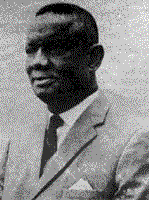 and much later at Ruskin College, Oxford, where he studied Trade Unionism.
On leaving school, Stevens jointed the Sierra Leone Police Force
and rose to the rank of First Class Sergeant and Musketry Instructor. From
1931 to 1946, he worked on the construction of the Sierra Leone Development
Company (DELCO) railway, linking the Port of Pepel with the iron ore mines
at Marampa. He later became station master and stenographer at Marampa.
A co-founder of the United Mine Workers Union, he was appointed to the
Protectorate Assembly in 1946 to represent the interests of workers. Elected
to the Legislative Council in 1951 as second protectorate member, he was
appointed in 1952 as Sierra Leone's first Minister of Mines, Lands and
Labour. In 1957, he was elected to the House of Representatives as member
for Port Loko East Constituency, but lost his seat as a result of an election
petition. He later fell out with the leadership of the ruling S.L.P.P.
and broke away to help found the People's National Party, of which he became
the first Secretary-General and Deputy Leader.
and much later at Ruskin College, Oxford, where he studied Trade Unionism.
On leaving school, Stevens jointed the Sierra Leone Police Force
and rose to the rank of First Class Sergeant and Musketry Instructor. From
1931 to 1946, he worked on the construction of the Sierra Leone Development
Company (DELCO) railway, linking the Port of Pepel with the iron ore mines
at Marampa. He later became station master and stenographer at Marampa.
A co-founder of the United Mine Workers Union, he was appointed to the
Protectorate Assembly in 1946 to represent the interests of workers. Elected
to the Legislative Council in 1951 as second protectorate member, he was
appointed in 1952 as Sierra Leone's first Minister of Mines, Lands and
Labour. In 1957, he was elected to the House of Representatives as member
for Port Loko East Constituency, but lost his seat as a result of an election
petition. He later fell out with the leadership of the ruling S.L.P.P.
and broke away to help found the People's National Party, of which he became
the first Secretary-General and Deputy Leader.
When the United National Front (U..N.F.) government was formed in 1959,
Siaka Stevens was not included in the cabinet since he had earlier lost
his seat due to an election petition against him. He did however participate
in the Independence Talks in London as the Deputy Leader of the P.N.P.,
which had then become part of the U.N.F. On the conclusion of the talks,
however, Siaka Stevens was the only delegate who refused to sign the Independence
Agreement on the grounds that there had been a secret defence pact between
Sierra Leone and Britain. The U.N.F. position that there would be no elections
before independence may have been the main reason for Siaka's refusal to
sign, since this position would have effectively shut him out of the political
process. Siaka was promptly expelled from the party on this return from
Britain, but less than a month after his expulsion, he launched his Elections
Before Independence Movement (EBIM) which was later to be transformed into
the A.P.C.
Siaka Stevens successfully exploited the disenchantment of northern
and eastern ethnic groups with the S.L.P.P. to forge the A.P.C. with such
northern leaders as S.I. Koroma, C.A. Kamara-Taylor, M.O. Bash-Taqui, S.A.T.
Koroma and S.A. Fofana, and to forge an alliance with the prominent Kono
political leader, PC T.S. M'briwa, and his Sierra Leone Independence Movement
(S.L.I.M.) In the 1962 general elections, Stevens' A.P.C. became the main
opposition party, winning sixteen seats, while Stevens himself was returned
to parliament as member for Freetown West II. He served the municipality
as mayor in the same year. His party won the 1967 general elections, with
Stevens retaining his seat in the Freetown West II constituency. He was
appointed Prime Minister, but was detained by the military and denied the
Premiership until the overthrow of the military government of the National
Reformation Council (N.R.C.) in 1968, when he was reappointed Prime Minister.
In April 1971, he introduced a Republican Constitution and became President
of the Republic a day after the constitution had been ratified by parliament.
The first general elections under the Republican Constitution were held
in 1973, but the elections were marked by so much violence that the opposition
S.L.P.P. withdrew. The year 1978 saw the introduction of a one party constitution,
and this marked the end of opposition parties in Sierra Leone. Siaka Stevens
survived two attempted coups d'etat, and met violence with violence. However,
as he succeeded in consolidating power in his hands, violence and political
tensions gradually subsided.
Siaka Stevens sought to open the ranks of the party to all sectors of
the community and to maintain a rough balance between ethnic groups, academics,
clerics, businessmen and traditional rulers. His later years in office
saw the gradual moulding of diverse groups into a unified nation, the progressive
lessening of cultural and regional tensions, and the creation of a more
homogeneous political community. The overall impact of these developments
was to provide relative stability and gradual acceptance by all Sierra
Leoneans of the authority of the A.P.C. government. It was little wonder
therefore that there was no hitch when the time came for Siaka Stevens
to pass on the mantle of leadership to a younger man. He will long be remembered
for his wise sayings, and it could be said that he heard "Sh Sh..." and,
being the wise chicken he always has been, got out of the way before a
stone hit him on the head.
Doctor Stevens died on 28th May 1988 in Freetown.
CHRISTIAN ALUSINE KAMARA-TAYLOR
(1917-1985)
ASTUTE POLITICIAN AND FOUNDER MEMBER OF THE A.P.C.
Popular known as "C.A.," the late Christian Alusine Kamara-Taylor was
born on June 3rd, 1917 at Kafanta, Tonko Limba Chiefdom, in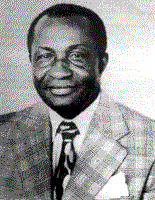 what is now Kambia District. A political activist, educator and trade unionist,
he contributed much to the political and socio-economic development of
Sierra Leone.
what is now Kambia District. A political activist, educator and trade unionist,
he contributed much to the political and socio-economic development of
Sierra Leone.
He was educated at a local primary school, the Methodist Boys' High
School and the London School of Accountancy, where he obtained a diploma
in Business Methods. He returned home and gained employment as a clerk
for the Sierra Leone Development Company. He later joined the Sierra Leone
Regiment, rising to the position of sergeant. He saw service in Burma during
World War II, but left the army after the war. He then joined the United
African Company, and became public relations officer and secretary to the
general manager.
Mr. Kamara-Taylor became active in local politics and was a foundation
member of the A.P.C. He served as the first secretary-general of the party,
a position he handled admirably for over fifteen years. He entered parliament
in 1957. He contested the 1962 elections, and was elected M.P. for Kambia
East Constituency. He retained his seat in the 1967 general elections and,
after the return to civilian rule in 1968, was appointed Minister of Lands,
Mines and Labour. Following a cabinet reshuffle in 1971, he was appointed
Minister of Finance. He became Prime Minister and Minister of Interior
in 1975. After the introduction of a one party constitution in 1978, Mr.
C.A. Kamara-Taylor became Second Vice-President, and held that post until
his death in 1985.
As a politician, he tried to foster integration among the various ethnic
groups. Many will recall his selflessness when, at a crucial point during
opposition days, he volunteered to answer to charges preferred against
Siaka Stevens. The conviction and possible imprisonment, of Siaka Stevens
then could have spelt the end of the A.P.C.
The solemn state funeral that was accorded him at his death was a fitting
tribute to the contribution he made to the development of Sierra Leone.
SORIE IBRAHIM KOROMA
(1930-)
POLITICAL ORGANISER AND TACTICIAN
Sorie Ibrahim Koroma was born in Port Loko, Maforki Chiefdom, Port Loko
District, in 1930. On of Sierra Leone's most vibrant political 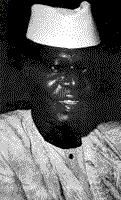 figures, S.I. Koroma was also involved in the labour movement of the 1950s.
He blazed the trail for the implementation of the self-help idea which
was an important aspect of rural development during the 1970s.
figures, S.I. Koroma was also involved in the labour movement of the 1950s.
He blazed the trail for the implementation of the self-help idea which
was an important aspect of rural development during the 1970s.
Educated at the Government Model School, Freetown, and at the Bo Government
School, Mr. Koroma worked in the co-operative department from 1951 to 1958
and took a course during that time at the Co-operative College, Ibadan,
Nigeria. In 1958, he resigned from government and went into private business
while also becoming the first secretary-general of the Sierra Leone Motor
Transport Union.
He was one of the founder members of the A.P.C., formed in 1960, and
became the party's first National Propaganda and Organising Secretary.
In this role, Mr. Koroma did his best to educate the people about their
political rights, and won astounding success in bringing the A.P.C. to
the people and increasing the popularity of the party. In 1962, S.I. Koroma
was elected to parliament as M.P. for Freetown Central I Constituency.
In 1967, he was returned to parliament for the same constituency. Following
the return to civilian rule in 1968, he became Minister of Trade and Industry
in Siaka Stevens' first cabinet.. In a cabinet reshuffle in 1969, he was
appointed Minister of Agriculture and National Resources. On the attainment
of republican status in 1971, S.I. Koroma became Vice-President and Prime
Minister, and in another cabinet reshuffle in 1975 he was made Vice-President
and Minister of Finance. Following the 1978 one party referendum, he was
appointed First Vice-President, a position he held until his retirement
from politics in 1986.
Popularly known as "S.I.," Mr. Koroma epitomised the hard-working, disciplined
and relentless leader who was willing to lead his forces against any foe.
He led the A.P.C. in many skirmishes during the early days then the party
had to fight for its very survival.. As the second-in-command in the party
hierarchy, many people believe that his faithfulness and his untiring dedication
to the defence of the A.P.C. at all costs sustained the party up to his
retirement. For this relentless defence, he earned himself many enemies.
Mr. Koroma was for a long time the number two man of the party, but
bowed out of the race for succession to Siaka Stevens when it became
clear that Major-General Momoh had the support of the rank and file of
the party as well as of the general populace. Mr. Koroma continues to be
a high-ranking member of the ruling A.P.C. party, but has retired from
government to devote his time and attention to the management of his oil
palm plantation near his home town of Port Loko.
TAMBA SONGU M'BRIWA
(1910-1968)
PROMINENT KONO LEADER
Paramount Chief Tamba Songu M'briwa was born at Jagbwema, Fiama Chiefdom,
in what became Kono District, the Eastern Province 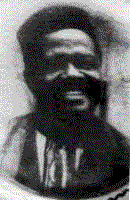 of Sierra Leone. He was an active politician who formed one of the Sierra
Leone's few political parties before independence.
of Sierra Leone. He was an active politician who formed one of the Sierra
Leone's few political parties before independence.
He was educated at a local primary school before proceeding to the Bo
Government School. He worked as a government dispenser before he became
paramount chief. As a paramount chief in the colonial era, Tamba Songu
M'briwa did much to improve the lot of his people. He established schools
in his chiefdom and was generally devoted to the education of the young.
As a politician, he formed the Sierra Leone People's Independence Movement
(S.L.P.I.M.) later renamed the Kono People's Union (K.P.U.) As leader of
his party he tried to inculcate a sense of responsibility in his followers,
and did his best to educate the Kono people on their political rights.
His party became so popular and famous in the Kono District that the S.L.P.P.,
a rival political party, never won a single seat in local government elections
in the Kono District during the existence of the K.P.U.
He was a fearless leader who was highly respected for his selflessness,
which won him the admiration of many positive-thinking Sierra Leoneans.
Convinced of the need for unity, he did much in the way of bringing together
the various and varied ethnic groups in cosmopolitan Kono into his political
party.
He remained a popular politician and a prominent paramount chief until
he fell out with Sir Milton Margai. He was subsequently suspended from
office and banished to Kamakwie in the Bombali District, Northern Province.
He was eventually reinstated and later joined forces with the A.P.C., assisting
in the victory of the A.P.C. over the S..L.P.P. in the 1967 general elections.
T.S. M'briwa, the fiery Kono leader, died in 1968, a few days after
winning the by-elections as Paramount Chief Member for Kono District in
the Sierra Leone Parliament.
Credits:
Muctaru R. A. Kabba - Editorial Consultant
Professor C. Magbaily Fyle - Historical Consultant
Joseph Opala - Historical Consultant and Adviser on Historical Drawings
Vera Viditz-Ward - Consultant on Historical Photographs
Josef Marker & Munir D. Mohamed - Drawings
|
|